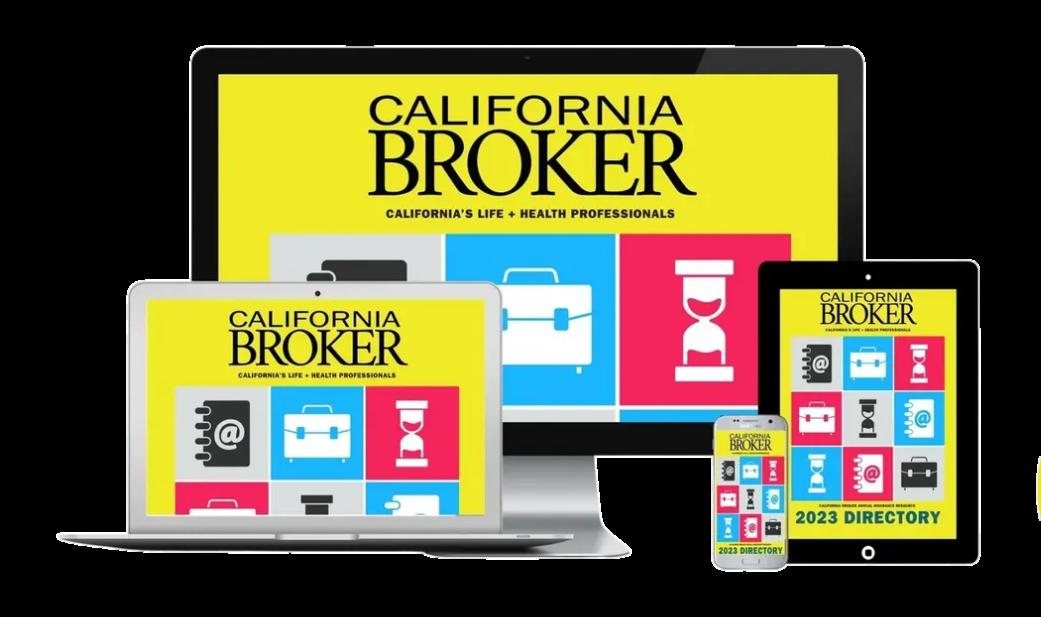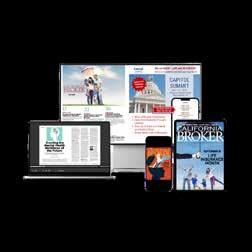



SERVING CALIFORNIA’S ANNUITY, LIFE AND HEALTH INSURANCE PROFESSIONALS / JULY 2023 COLLABORATION / HUMOR / MARKETING Subscribeto CONTINUE YourPrintMagazine GotoPage24forSubscriptionDetails PLEASEACTTODAY
[&] Effect Elements [Passion. Authenticity. Collaboration. Trust.]
The [&] Effect is a feeling. It’s the confidence you have working with authentic people who thrive on collaboration. It’s the security of having your business handled by a team passionate about your success. It’s the gift of time you’re granted because you have a partner you can trust.

It’s a phenomenon only experienced with Word & Brown by your side.

48 | CALIFORNIA BROKER JULY 2023 CalBrokerMag.com Experience Word & Brown | wordandbrown.com Northern California 800.255.9673 | Inland Empire 877.225.0988 | Los Angeles 800.560.5614 | Orange 800.869.6989 | San Diego 800.397.3381
When your clients are traveling abroad, whether for a long stay or a short visit, protect them with GeoBlue® travel health insurance. They’ll be able to choose from the most complete set of benefits and services in the industry, including medically necessary COVID-19 coverage. GeoBlue single trip and expatriate plans also include crucial benefits such as medical evacuation, access to a trusted provider network, direct pay for care, 24/7 support and peace of mind.
Learn more and register for your Agent ID at geobluetravelinsurance.com, contact us toll-free at 1-844-669-8743 or email us at partnerprogram@geo-blue.com.

All insurance policies and group benefit plans contain exclusions and limitations. We recommend you consult the policy for coverage and benefit details. GeoBlue is the trade name of Worldwide Insurance Services, LLC (Worldwide Services Insurance Agency, LLC in California and New York), an independent licensee of the Blue Cross and Blue Shield Association. GeoBlue is the administrator of coverage provided under insurance policies issued by 4 Ever Life International Limited, Bermuda, an independent licensee of the Blue Cross Blue Shield Association. INDV2249-BRK-9/22
THE JOURNEY OF A THOUSAND MILES BEGINS WITH THE RIGHT HEALTH INSURANCE.
TABLE of CONTENTS
12
MENTAL HEALTH
The power of the giggle, the chortle, the snort!
Grasp the Power of Humor —
Use it to build connection and health
By Karyn Buxman
What’s the sound of 8 billion people laughing? World peace. Can you recall the last time that you laughed so hard your face hurt? If you’re still trying to remember when…keep reading!
16
MARKETING
The Power of Social Media Marketing
How brokers can make real money using free tools
By Sandra Gebhardt
Social media can feel overwhelming, usually because we don’t know how to use it. The very first thing we need to do is to realize that social media is a tool.
18
MEDICARE
Adapting to the Latest CMS’s Regulations
A Breakdown of 2024 MA and Part D Final Rule Changes for Agents
By Austin Felch
The Centers for Medicare & Medicaid Services (CMS) has recently released the final rule for Contract Year 2024, outlining key changes that will impact sales processes.
Cal Broker’s commitment is to be the leading source of news and information for California brokers and agents operating in the health, life, and annuity industry. We are committed to connecting Life and Health insurance professionals to valuable resources and solutions they can provide to their insurance clients.
20
MEDICARE SUMMIT SPEAKER
Three Ways to Positively Disrupt Your Mindset Each Day
By Tony Rubleski
…when we turn inward and redirect our daily thoughts with positive questions and gratitude, we can significantly improve our lives for the better
22
COLLABORATION
Solve Client Issues: Collaborate with a Subject Matter Expert
How Health Insurance Professionals Can Find Collaborative Partners
By Danny Wexler
Successful health insurance professionals reach out to specialists to find the right solution when their client’s issues are outside of their expertise.
24 TRANSITIONS
CalBroker Introduces $18 paid print subscription, free digital, and paid eDirectory options with bonus print subcription
26
LEGISLATION
No Surprises Act Protects Against Balance Billing
Help your clients using Reference
Based Pricing
By Christine Cooper
More than a year ago, the U.S. healthcare system marked a turning point with the passage of the No Surprises Act (NSA) to address concerns about “balance billing.”
30
SMALL GROUP
The Benefits and Risks of Level Funding for Small Employers
Eight tips for brokers
By Nancy Giacolone
Level funding is an increasingly popular option for small employers looking to provide health insurance benefits to their employees.
4 | CALIFORNIA BROKER JULY 2023 CalBrokerMag.com 2023 JULY
CALIFORNIA’S
SERVING
ANNUITY, LIFE AND HEALTH INSURANCE PROFESSIONALS
32
In the Workplace: The Case for LongTerm Care Insurance and Disability Insurance
By Marc Glickman
More employers are considering a longterm care insurance benefit for their employees. This additional benefit can help attract and retain great talent and also help employees better plan for their own futures.
34
TECHNOLOGY
Small business and HR Tech: an untapped market
By Wendra Johnson
Today’s employees are feeling financial strain. In a recent Unum survey we learned that 46% of workers have less than $1,000 in their checking/savings account and almost half of workers could only avoid financial distress for two months or less if they couldn’t work.
36 VISION
The Clear Benefit of Vision Coverage
Essential part of whole-person health
By John Wiesler
It’s tempting to think of vision coverage as an extra, but employers and employees should approach vision care as an essential part of whole-person health.
38
Making Benefits Work for Working Women
By Lisa Wolf
The number of women at work was recently reported at 77.8 million — higher than pre-pandemic levels for the first time.
40
OPINION
Prediction: Tech and Retail Continue to Inch Into Healthcare Delivery
With the healthcare industry accounting for nearly 20% of the GDP, it holds great allure for non-healthcare companies seeking to expand their revenue streams. Dawn Maroney, CEO of Alignment Health Plan and President of Markets of Alignment Health weighs in.
41
Retail Clinics Target Chronic Diseases
Offer lower cost and greater convenience in higher-income areas, but rural and underserved are out of picture
Retail health clinics are growing not only in number but in scope of services delivered.
44
GROUP BENEFITS
Fourth Quarter Prep Planning - an ongoing series Preparing for Client Renewals
From CalBroker Magazine
The Group benefit brokers we spoke with know how important it is to prepare for their client renewals. Preparation can make a huge difference when working with clients.
PUBLISHER
Phil Calhoun HealtH Broker PuBlisHing, llC publisher@calbrokermag.com
EDITOR Linda Hubbard Lalande editor@calbrokermag.com linda@calbrokermag.com
ART DIRECTOR Randy Dunbar Randy@calbrokermag.com
PRODUCTION ASSOCIATE Zulma Mazariegos Zulma@calbrokermag.com
DIGITAL DIRECTOR Carmen Ponce Carmen@calbrokermag.com
CIRCULATION calbrokermag@calbrokermag.com
ADVERTISING
Health Broker Publishing 14771 Plaza Drive Suite C Tustin, CA92780 714-664-0311 advertising@calbrokermag.com calbrokermag@calbrokermag.com
Subscriptions: U.S. one year: $18. Send change of address notification at least 20 days prior to effective date; include old/new address to:
Health BrokerPublishing 14771 Plaza Drive Suite C •Tustin, CA92780 714-664-0311
California Broker (ISSN #0883-6159) is published monthly. Periodicals Postage Rates Paid at Burbank, CAand additional entry offices (USPS #744-450).
POSTMASTER: Send address changes to California Broker, 14771 Plaza Drive Suite C •Tustin, CA 92780
©2023 by Health Broker Publishing. All rights reserved No part of this publication should be reproduced without consent of the publisher.
No responsibility will be assumed for unsolicited editorial contributions. Manuscripts or other material to be returned should be accompanied by a selfaddressed stamped envelope adequate to return the material.The publishers of this magazine do not assume responsibility for statements made by their advertisers or contributors.
JULY 2023 CALIFORNIA BROKER | 5 CalBrokerMag.com IN EVERY ISSUE Industry News 7 Ad Index 46
Printed and mailed by Southwest Offset Printing, Gardena, Calif. LTC
a partnership that pays
BONUS PROGRAM - COVERAGE EFFECTIVE: JULY 1, 2023 TO JANUARY 1, 2024
Earn even more for offering your clients California’s most comprehensive access to doctors and hospitals:
Full Network PPO
• Blue Shield
HMO offerings from
• Blue Shield

• Kaiser Permanente
• Sharp Health Plan
CCSB offers 4-tier selection
Single bill
NEW! CCSB offers more Blue Shield Plans


Some Key Rules:
1. Applies to new to Covered California for Small Business (CCSB) groups with initial effective dates of 07/1/23, 08/1/23, 09/1/23, 10/1/23, 11/1/23, 12/1/23 and 1/1/24
2. Agency must submit minimum of three groups to qualify for bonus program
3. Bonuses will be calculated on number of subscribers (employees) in e ect for the first e ective month of the policy as determined by CCSB.
4. No pro-ration of target values will take place.
5. Business written through partnering General Agencies qualifies.
6. Covered California will issue the second bonus (6+ groups) incentive payment forty-five (45) days following the conclusion of the incentive program so long as qualifying groups satisfy the ninety (90) day requirement outlined in Section (E)(2)(c) of Exhibit F of the Agency Agreement.



For a complete list of the program rules go to: http://www.coveredca.com/agents/PDFs/Agent-commission-schedule.pdf

Contact your local Covered California for Small Business sales representative to learn why we’re growing and how we can help build your business! An increasing number of agents and their clients
did.
EXTRA WHEN
NEW SMALL
are glad they
EARN
YOU SELL
GROUPS
Group Size (Enrolled Employees) Bonus Per Group (3 Groups / 6+ Groups) 51 - 100 $ 8,000 / $12,000 26 - 50 $ 4,000 / $6,000 11 - 25 $ 2,000 / $3,000
- 10 $ 1,000 / $1,500
4
CoveredCA.com/ForSmallBusiness 844.332.8384
*Insurance companies vary by region and are subject to change. ® ccsb_12675_23_bonus
What Type of Exercise Is Best for Mental Health?
A large new study looks at how exercise can help alleviate symptoms of anxiety and depression.
When you head to your weekly yoga class or lift weights at the gym, you’re doing something good for your physical health: getting more fit today, and so protecting your body into the future.

What you may not always think about, though, is that you’re also protecting yourself from anxiety and depression — about as much as you would be if you were going to therapy or taking medication. At least that’s the conclusion of a very large new study that synthesizes decades of research on exercise and mental health.
The study doesn’t just provide this key insight — in fact, the researchers were also able to identify what kind of exercise and how much of it is best for mental health. The findings suggest that exercise is particularly helpful in certain situations. While the type of exercise didn’t matter, people got more mental health benefits out of higher-intensity exercise. If you’re doing something that makes you breathe hard, in other words, that’s a good sign.
Tips for starting an exercise regimen
> Start small.
> Find an activity you enjoy.
> Make exercise a habit.
> Set realistic goals.
> Reward yourself (but not with FOOD - HA!)
> Don’t give up.
More:
greatergood.berkeley.edu/article/item/what_type_of_exercise_is_best_for_mental_health?
INTERNATIONAL JOKE DAY – JULY 1, 2023

�� What treat do dads like on the 4th of July? POPsicles.
�� How do pandas stay cool in July? They use bear conditioning
And thus begins another International Joke Day on July 1. Where would any of us be without jokes and laughter to brighten our spirits? It can help any situation. Take some time out to recognize the importance humor plays in keeping stress at bay, building relationships, and bringing levity to a world that badly needs it. And be sure not to confuse the purpose of International Joke Day with April Fools’ Day — the two couldn’t be further apart. July 1 is all about getting a grin out of your best friend, sharing a laugh on social media, and appreciating the stand up comics who have left us in stitches for decades.
Speaking of stitches, that reminds me:
�� I asked the doctor the other day if I’d be able to play the piano once I got my stitches removed. “Yes,” he told me, “I imagine that won’t be a problem.” “Great,” I said. “I’ve always wanted to play a musical instrument.”
For more on the benefits of humor, Check out Karyn Buxman’s video: youtu.be/cJinHwgqb8s
�� And an article by Karyn in this issue on page 12 ��
JULY 2023 CALIFORNIA BROKER | 7 CalBrokerMag.com CURATED NEWS FROM THE INDUSTRY
Blue Shield of California
Recognized as One of the 50 Most Community-Minded Companies in the United States
Blue Shield of California was named a 2023 honoree of The Civic 50 by Points of Light, the world’s largest nonprofit organization dedicated to accelerating people-powered change.
One of Blue Shield of California’s crowning achievements has been the 2019 launch of its BlueSky youth mental health initiative. The program is currently providing extra counselors in 20 schools in California, alongside other resources, to boost the emotional well-being of middle and high school students.
Blue Shield has also been very active in corporate giving, funding dozens of nonprofits. Employees have also pitched in on this effort to support nonprofits to empower all Californians to live their healthiest, most productive and fulfilling lives. 2020 was a record-setting year for both volunteer hours (more than 30,000) and dollars (more than $1,000,000) donated by Blue Shield employees. So far in 2021 more than 60% of Blue Shield employees have donated more than 5,500 volunteer hours and $400,000 (including a company match) to worthy causes.
How companies can rethink life insurance benefits for their employees
By providing your employees with additional coverage, you’ll be able to capture them early in the career lifecycle and ensure greater employee satisfaction and loyalty. Spurred by COVID, the Great Resignation, and changing demographics, the U.S. jobs market has changed a great deal in the past few years.
www.benefitspro.com/2023/06/12/ how-companies-can-rethinklife-insurance-benefits-for-theiremployees
WHAT IS VALUE-BASED CARE? WHAT DOES IT MEAN FOR PROVIDERS?
Kaiser Family Foundation survey of consumer experiences with health insurance
Understanding how health insurance works involves exploring how people feel about their health coverage, how affordable that coverage is, how they interact with their insurance provider, the problems they experience, and, critically, how insurance works for people when they get sick.
Key Findings
Most insured adults give their health insurance positive ratings, though people in poorer health tend to give lower ratings. Most insured adults (81%) give their health insurance an overall rating of “excellent” or “good,” though ratings vary based on health status: 84% of people who describe their physical health status as at least “good” rate insurance positively, compared to 68% of people in “fair” or “poor” health. Ratings are positive across insurance types, though higher shares of adults on Medicare rate their insurance positively (91%) and somewhat lower shares of those with Affordable Care Act (ACA) Marketplace coverage give their insurance a positive rating (73%).
Link: www.kff.org/private-insurance/poll-finding/kff-survey-of-consumerexperiences-with-health-insurance/
Aug. 6-7
CAHIP Region 8 Conference, Anaheim
Aug. 16 8am - 5:30pm
CAHIP Los Angeles, Ventura County and Santa Barbara host “Medicare on the LA LA Land Stage”

The Odyssey, Granada Hills. Get ready for a prosperous 2023 AEP.
Info & registration: www.laahu.org
Aug. 22-24
“Senior Summit: Exploring the Medicare Jungle” Pechanga Resort, Temecula.
JULY 2023 CALIFORNIA BROKER | 9 CalBrokerMag.com
Congratulations to former CAHIP President and VP of Communications Dorothy Cociu!

Dorothy Cociu's company Advanced Benefit Consulting & Insurance Services, Inc. was selected as #1 of the Top 20 Employee Benefits Solutions Providers for 2023 by HR Tech Outlook magazine in their June 2023 Employee Benefits Issue. This is their third national HR Magazine recognition in 12 months. Congratulations Dorothy on this wonderful achievement!

From CAHIP Connection, June 2023.
AHIP SURVEY: Most prefer their employer-provided health coverage
A recent survey conducted by AHIP’s Campaign@Work found that most respondents had a favorable opinion of their employer-provided coverage.
Employer-provided coverage continues to play an integral part in ensuring Americans have access to affordable, high-quality health care. Most consumers (63%) are satisfied with their current employer-provided coverage, and the vast majority (68%) prefer to get their coverage through their employer rather than through the federal or state government. This satisfaction is driven by the comprehensive coverage, affordability, and choice of providers their plans provide. In addition, a majority (59%) feel the quality of their current health insurance plan is high.
During this time of high inflation and rising cost of living, costs remain a top concern for consumers. Encouragingly, a majority of those with employerprovided coverage (53%) report that what they currently pay for coverage overall is reasonable.
Even though costs are the largest driver of plan dissatisfaction, it matters more to consumers that their coverage is comprehensive (60%) as opposed to affordable (40%). Consumers report that the plan benefits they value most are emergency care (62%), prescription drugs (58%), and preventive care (55%).
Read more: www.ahip.org/resources/the-value-of-employer-provided-coverage-in-2023
Biden administration announces lower out-ofpocket prescription drug costs for 43 drugs
TheStreet
The Biden Administration announced that the Inflation Reduction Act is continuing to lower out-of-pocket prescription drug costs for Medicare beneficiaries. As of July 1, 2023, coinsurances for 43 drugs will be lower for beneficiaries who take these medications. The savings will range from $1 to $372 per average dose, depending on the individual coverage.
The Inflation Reduction Act is one of a number of steps the Biden Administration has taken to lower the cost of prescription drugs. In March, the administration announced a plan to allow Medicare to negotiate drug prices for the first time. The administration is also working to increase competition in the prescription drug market and to make it easier for generic drugs to enter the market.
Factsheet: https://www.cms.gov/ files/document/fact-sheet-partb-rebatable-drug-coinsurancereduction.pdf
Read more in The Street: www.thestreet.com/retirement-daily/ social-security-medicare/bidenadministration-announces-lower-outof-pocket-prescription-drug-costs-for43-drugs
Future of Benefits Report 2023
An HR Leader’s Guide to What’s Next in Employee Benefits in 2023
In Care’s latest Future of Benefits report, 95% of HR leaders report they plan to recalibrate their benefits in 2023 and 47% plan to trim benefits due to economic shifts.
OCAHU Event Supports New Hope Foundation
On June 2, CAHIP Orange County (OCAHU) held their annual Celebration of Women in Business Fashion Show and Luncheon benefiting New Hope Grief Support Community. Since the event’s 20th Anniversary coincided with New Hope’s 20th Anniversary, the Roaring Twenties was the perfect theme. The past honorees were guests for the day and were recognized with admiration for their past achievements. The amazing raffle baskets were the highlight of the day and the winners walked away with hundreds of dollars in goodies. It was a fabulous day raising money for a remarkable charity! Join at OCAHU.com
Want to know which benefits they are trimming, which they are prioritizing, and the business impact this reshuffling has on employers?
Download: https://bit.ly/43Jvq2p
10 | CALIFORNIA BROKER JULY 2023 CalBrokerMag.com
Failure to Survive Product Line
With liberal underwriting standards and unique flexibility, the Failure To Survive coverage provides a death benefit, and can accommodate impairedrisk cases that would typically be declined or postponed by traditional market carriers.

•Contract Indemnity FTS

•Key Person FTS
•Buy/Sell FTS
•Business Loan FTS




FAILURE TO SURVIVE LOAN INDEMNITY CONTRACT INDEMNITY BUY/SELL INDEMNITY KEY PERSON INDEMNITY ® CA License #: 0591207 Petersen International Underwriters (800)345-8816 F www.piu.org F piu@piu.org When Traditional Carriers Can’t...or Won’t ® ®
Build New Business and Help Baby Boomer Brokers too!

TRAINING NOW AVAILABLE: “BABY BOOMER BROKERS NEED AN EXIT PLAN”

ALL Baby Boomer Brokers either: Want to retire soon, OR Stay ACTIVE but need their commissions protected. Sign up for the “Baby Boomers Need an Exit Plan” Course to gain the following:
• Learn Proven Tools to HELP Brokers AND Increase Your Commissions

• Spend less time and money to ADD new Clients
• STOP feeding people at seminars to get leads

• Don’t pay for mailers to find prospects

• Use a proven targeted approach to build new commissions and ADD new clients! ADD new Group or Medicare clients with our “Baby Boomers Need an Exit Plan” strategy and take advantage of the retirement wave as thousands of Baby Boomers exit the business.
Provide Baby Boomers with an Exit Plan to help solve the massive retirement of Baby Boomer brokers hitting NOW and over the next 10 years!
The personalized The Baby Boomers Need an Exit Plan 3-hour course is only $3,500.
To learn more, email phil@commission.solutions www.commission.solutions (NO .com needed)

Expect More FROM
Broker Support: Paperless. Secure. Cohesive. ©2023 BenefitMall. All Rights
YOUR GENERAL AGENCY Premier
Reserved.
The power of the giggle, the chortle, the snort!
Grasp the Power of Humor — Use it to build connection and health
BY KARYN BUXMAN
July First is International Joke Day :)
What’s the sound of 8 billion people laughing? World peace. And what better way to give peace a chance than International Joke Day! Yes, there really is such a thing and it’s on July 1st. If children ruled the world, everyday would be International Joke Day. But many of us need to be reminded to lighten up, have fun, and double over laughing with our friends. (Can you recall the last time that you laughed so hard your face hurt? If you’re still trying to remember when…keep reading!)
We’re hardwired to laugh
As a neurohumorist, I’ve spent the last 30 years studying the intersection of humor and the brain — and one of the coolest things I discovered is that people are hardwired to laugh. It’s in our very DNA. Babies who are born blind and deaf still laugh. It’s part of what makes us human. While there are studies that suggest rats laugh when they’re tickled, they don’t laugh at jokes (don’t ask me how I know this).
Needing insurance is like needing a parachute. If it isn´t there the first time, chances are you won´t be needing it again.
Laughter has no accent
Regardless of our race, gender, religion, or Facebook status — if we’re born healthy, we begin smiling at around two months old. It’s a riot to watch adults make silly faces and goofy sounds all for the grand payoff of getting a baby to smile. And about a month after smiling takes place comes the baby’s laughter! I don’t know about you, but I don’t think there is any sound more beautiful (or contagious) in the world than a baby’s laugh.
As we grow up in our different cultures, what makes us laugh starts to become more diverse. The words we use to create our jokes take on different sounds and cadences. But close your eyes and listen to someone laugh. You can’t tell a person’s color or ethnic background, if they’re rich or poor, or if they’re fully insured or uninsured!
☺ “Humor is the universal solvent against the abrasive elements of life. It breaks down barriers and helps us find common ground.”
~Allen Klein
Not all jokes are created equal
While our laughter may sound the same, what makes us laugh is different. And here’s where you, as an insurance professional, are going to want to start giving this some serious thought. (I know that taking humor seriously sounds like a paradox, but bear with me.)
Almost every joke has a target. Some are more subtle than others. Some jokes are gentle (cue the Dad jokes…). And some are deadly (Google Charlie Hebdo). Generally speaking, men tend to lean more toward jokes while women tend to lean more toward funny stories.
When I poll my audiences as to who are good joke tellers, only a small percentage raise their hands. Many can’t remember the punch line, or their delivery goes on and on (and on) basically killing the joke. But I believe anyone could benefit from learning at least one short joke. Find one that resonates, practice it out loud at least seven times, and then try it out on your kids, your colleagues, and your Uber driver. I can assure you there are times when a quick joke comes in handy. Here are a few to get you started.
�� Why did the golfer wear two pairs of pants? In case she got a hole in one!
�� I ordered a chicken and an egg online. I’ll let you know which comes first.
☹ What kind of cheese isn’t your cheese? Nacho cheese.|
�� I always take life with a grain of salt. And a slice of lemon. And a shot of tequila.
���� What do you call a sad cup of coffee? Depresso.
MENTAL HEALTH
��
12 | CALIFORNIA BROKER JULY 2023 CalBrokerMag.com

DEI and humor
Using humor in your sales approach can help build rapport with your clients – and strengthen your bond over time.
Because you’re using humor to influence, and not to entertain, you have a different set of guidelines than that of a comedian. The goal of a standup comic is to get their audience to laugh. Almost anything is fair game as long as they get a laugh.
Your goal, however, is to influence others. And your success isn’t measured in laughs per minute. Your success is measured by how much your client trusts you and how willing they are to buy from you. Different goals—different rules.
If a comic offends their audience, the audience member can leave or change the channel. If YOU offend YOUR audience, they can also leave—and take their business with them. Are you willing to risk it?
Think about diversity, equality and inclusion (DEI) when sharing a joke to make your humor more successful. Taking the time to know more about your prospect’s or client’s background, culture, education, likes and dislikes can prevent stepping on unnecessary landmines.
����☺ What’s Forrest Gump’s password?1forrest1
Why bother?
We’ve known since before Biblical times that laughter is good for us. However, the field of applied and therapeutic humor is relatively new in comparison to other fields in science.
infections). Humor has also been shown to help with autoimmune diseases such as eczema.
•Endocrine: In persons who are pre-diabetic or diabetic, humor can lower blood glucose levels as well as lower renin and angiotensin, which are proteins that can cause kidney damage.
•In my TedX Talk on YouTube, “How Humor Saved the World,” I go into more detail about humor even being linked to changes at the level of DNA—epigenetics! (https://youtu. be/5bOriPEk7S8)
Psychological Wellbeing
Tricky traffic, cranky clients, daunting deadlines…you can feel anxious just thinking about these things. It’s called an anticipatory response. But get this—humor lowers anxiety, decreases anger, and has even been shown to help with depression. And humor also has an anticipatory response. Just thinking about something funny can counteract your body’s stress response, leaving you thinking more clearly and feeling happier.
☺ The patient told his doctor, “I can’t figure out what’s wrong with me. First, I feel like a wigwam. Then I feel like a teepee.” The doctor replied, “It’s nothing serious. You’re two tents.”
Social Wellbeing
��
“A merry heart doeth good like a medicine, but a broken spirit drieth the bones.” ~ Proverbs 17:22
You may have heard the story of Norman Cousins who reversed his painful and potentially terminal illness with the help of his friend, Allen Funt. (If don’t recognize the name Allen Funt, go to YouTube and search for Candid Camera.) Cousins made laughter a significant part of his therapeutic regime and made a complete recovery. In 1979 Cousins published his experience in his book, Anatomy of an Illness, and subsequently the field of psychoneuroimmunology (aka mindbody connection) became mainstream. Now scientists around the world demonstrate that humor isn’t just goodmedicine—it’s amazing!
Physical Wellbeing
We’ve known for years that stress takes its toll on us. It can pound every system in our body and fan the flames of all sorts of diseases. But great news: for every body system that stress affects negatively, humor can affect positively. Here are a few:
•Cardiovascular system: can lower blood pressure and LDL (the “bad” cholesterol).
•Musculoskeletal system: can reduce muscle tension in your back, shoulders, jaw, even your stomach muscles (ever laughed so hard you had to lean forward and hold on to a chair?!).
•Immune system: can boost white blood cells which fight infection, natural killer (NK) cells which help fight microbial infections and several types of tumors, as well as immunoglobulins (IgA is especially helpful in respiratory
We have a new epidemic that you may not have heard about. It’s not spread through in-person contact. In fact, quite the opposite. Surgeon General Dr. Vivek Murthy has declared an epidemic on loneliness and isolation. This issue, which was already a serious problem for many seniors and millennials, was exacerbated by Covid. This social challenge continues taking a huge toll.
“Our epidemic of loneliness and isolation has been an underappreciated public health crisis that has harmed individual and societal health. Our relationships are a source of healing and well-being hiding in plain sight — one that can help us live healthier, more fulfilled, and more productive lives,” said U.S. Surgeon General Dr. Vivek Murthy.
Fortunately, one of the benefits of humor is connection. Sharing a laugh creates a social bond. Strategically using humor to connect with others can help decrease your clients’ isolation. It’s also good news for you when creating connections with potential clients or strengthening your connection with existing clients.
SEE funny
It’s actually more important to SEE funny than to BE funny! If you practice the seeing funny the being funny will fall into place. Here’s one quick way and a short cut into the power of humor – raise your awareness. Ask yourself, “what’s funny around here? What am I missing? If you intentionally start listening for humor, you’ll find it.”
When I ask my audiences or coaching clients what’s holding them back from using more humor, one frequent response is “I’m not funny.” My answer? “Great!”
�� “Laughter’s the shortest distance between two people.”
~Victor Borge
14 | CALIFORNIA BROKER JULY 2023 CalBrokerMag.com
Remember, when you’re an entertainer, it’s your job to be funny. But when you’re an influencer, [KB1] your job is creating and maintaining relationships. You do this by leveraging humor. You don’t have to be the source of the laughs. You can use memes, videos, props, other people’s stories, and so much more. The trick is to recognize and leverage the humor around you. It’s more important to SEE funny than BE funny!
Which takes me to the next frequently heard protest: “There’s nothing funny happening in my life.” Listen…if that’s your belief, that’s your reality. If you believe there’s nothing funny around you, I can promise you that you’re not going to recognize something funny even if it gets up and wiggles in your face.
As you go through your day, ask yourself, “What’s funny?” It will take a little time to rewire your brain, but soon a part of your brain called the reticular activating system (RAS) will start to show you more of what you’re focusing on. You’ll begin seeing and hearing things that other people miss. Like…
���� The sign in the coffee shop that says, “Children left unattended will be given an espresso and a free puppy.”
Or the father with 4 kids in tow who asks the Miami hotel clerk, “Which beach is closest to the water?”
Or people with funny names like Chris P. Bacon or Krystal Ball or Jed I. Knight. Heard of Rusty Nails or Dusty Rhodes? You don’t have to make this stuff up!
Humor by choice—not chance
Be proactive. Don’t just wait and hope that something funny will happen. Seek humor from your clients, your colleagues, your barista! The world is your oyster. You’ll score points bigtime if you ask your client, Mrs. Smith, “What’s the funniest thing your grandson ever said?” Or ask your longtime colleague, “What’s the craziest thing a client’s ever asked you?” Or ask your barista, “What’s the weirdest coffee order you’ve ever gotten?” People say and do the funniest things.
�� “Gimme a trenti iced coffee, 12 pumps [sugar-free] vanilla, 12 pumps [sugar-free] hazelnut, 12 pumps [sugar-free] caramel, 5 pumps skinny mocha, a splash of soy, coffee to the star on the siren’s head, ice, double-blended!”
Starbucks Barista re: This is my first 41-pump-customer!
Ask folks to share with you. And here’s something you may not have thought about: Because you asked someone to share something funny with you, they will see you as having a sense of humor — even though you never said anything funny. And a sense of humor is a highly desirable trait in agents, customers, coworkers, bosses, vendors, and soul mates (more on that in a separate article!).
�� Eddie Valiant: “Seriously, what do you see in that guy?”
Jessica Rabbit: “He makes me laugh.”
Play it forward
If you acted on the previous step and collected some funny jokes and stories, now it’s time to play it forward. There are so many ways to share your comedy gold. As you grow your
collection of humor (and DO keep these valuables in a safe place!), you now have a repertoire to pull from when meeting with clients, holding a team meeting, or giving a presentation. When you share your humor with others, you are dousing their brains with hits of oxytocin and dopamine — and those feel great!
�� My new colleagues are so much fun, they write names on all the food. Yesterday, I ate a yogurt named ‘Susan’; how cute is that?
Humor is power.
People want to do business with someone who can solve their problems, but all things being equal, they prefer to do business with someone they know, like and trust. Humor has the power to create familiarity, likability, and confidence. When you share a goodhearted laugh, everyone wins. And just think…if everyone on this planet found one bit of humor they could share, then International Joke Day would be just another day, and we could relish the sound of 8 billion people laughing.
�� My wife told me to stop impersonating a flamingo. I had to put my foot down.
�� I used to have a handle on life, but then it broke.
☹ I was addicted to the hokey pokey, but then I turned myself around.
�� People who use selfie sticks really need to have a good, long look at themselves.
�� ‘Doctor, there’s a patient on line one that says she’s invisible.’ ‘Well, tell her I can’t see her right now.’
Resource: parade.com/1040121/marynliles/one-liners/
KARYN BUXMAN, CSP, CPAE, is CEO and founder of HighPerformanceHumor.com. She is a TEDx speaker, successful author, and neuro humorist (she lives at the intersection of humor and the brain.) A pioneer in the emerging science of applied humor, Karyn helps high performers expand their influence, strengthen their relationships, and boost their resilience. She’s one of 265 people (and only 58 women) in the world to be inducted into the National Speakers Association’s Speaker Hall of Fame. While addressing the Million Dollar Round Table Karyn once unified an international audience of over 10,000 insurance professionals from 78 countries with laughter that transcended the language barrier. Karyn is serious about humor!

www.HighPerformanceHumor.com
karyn@karynbuxman.com
Buxman was a 2023 Ellevate Foundation Women’s Leadership Summit Keynote Speaker. See coverage in our May issue: www.calbrokermag.com/in-this-issue/womens-leadershipsummit-watchwords-authenticity-connection-compassion-andvulnerability/.
JULY 2023
JULY2023 JULY 2023 CALIFORNIA BROKER | 15 CalBrokerMag.com
The Power of Social Media Marketing
How brokers can make real money using free tools
By Sandra Gebhardt
Social media can feel overwhelming, usually because we don’t know how to use it. The very first thing we need to do is to realize that social media is a tool. We often think of it as our escape from reality, our own distraction. Start looking at social media (Facebook, mainly) as a free advertising tool. You will find that you can start using it efficiently. We want to say out loud, “Facebook is for making money.” Once we get our mindset wrapped around that, you’ll find social media much easier to integrate into your day-to-day life.
Picture this…
You are able to put 5,000 people into a room and create your dream networking situation. Anyone can be in this room: referral partners, current clients, friends, fans, future clients, influencers of any sort, celebrities — the list goes on and on. Multiple times a day, you can share your dreams, thoughts, goals, details about your business, your family — the same sort of things you would share at a reallife networking event.
This is exactly what your personal Facebook profile does. You are able to hand-select 5,000 people to share your message with. If you don’t align with someone, you unfriend them or block them. This is not a luxury we even have in real-life networking situations. We tried in the 90’s with “Talk to the hand because the face isn’t listening,” but that never worked out all that great.
The power of posting, interacting
and starting conversations with people on your Facebook profile is unlimited. Creating real conversations, real business relationships, and business transactions happen daily.
That said, social media marketing can be a very time-consuming marketing tool for sure. But compare it to how much time you spend attending many social networking events in person. If you plan it right, and set up the tool to serve YOU, in around 20 minutes a day, you are able to strategically interact with your community online. Increase your interactions from real-life events. Create new powerful relationships from the comfort of your own home, in your pajamas.
Now, don’t confuse the type of social media marketing I am writing about with content creation. We are talking about using social media to create a strategic brand with people you select. Content creation includes businesses online that have a marketing team. They are shooting and editing many videos a day, posting on different platforms, staying on top of trends — it is a full-time job.
Most small business owners don’t have the budget for a full-time marketing person. You should not be spending your time away from the money-making activities you are skilled at. Rather, there is a very sweet spot that is often overlooked because it is not flashy, trendy, or overly cool. That sweet spot is using your social media to build knowledge, likes and trust. This by interacting and posting as if you were
interacting with people in real life. It is not flashy, but it is steady and true. Follow the system, and you will see your brand (you) becoming more noticeable. People will reach out to do business with you. Referral partners will reach out to see how you can help grow each other's businesses.
The 20 minute fool proof 5x5x5 system
To get you started, I am going to break down a quick system to increase your social media marketing efforts. The best part is, it only takes about twenty minutes a day.
1. Five Friend Requests: The 5x5x5 system starts with sending out 5 friend requests daily. Be strategic in who you are inviting to connect with you. Think about that dream networking situation. Who do you want to invite to your “networking event?” If you meet people in real life, ask them to connect online. Send a friend request right away.
2. Five Interactions: Next, we are going to interact with 5 different people. This simply means that we are going to find 5 posts to comment on. Comment the same way you would if you were talking to this person in real life. Be social and use 2-3 sentences to actually interact with their posts. Imagine that person is showing you the picture they posted or telling you the story face-to-face. Respond accordingly.
MARKETING
16 | CALIFORNIA BROKER JULY 2023 CalBrokerMag.com
3. Five Direct Messages: The third “5” is to send 5 direct messages to your connections. Don’t send a friend request and a direct message on the same day, unless you already have a connection. This is everyone's least favorite step. People share concerns about being too pushy, too salesy, or too annoying to others. It feels like a big deal to send someone a direct message, but it's NOT.

The only time it's a bad idea to send a direct message is if you are trying to only sell them something. If you are starting a direct message with a pitch for recruiting or a product, you are doing it wrong. If you are starting a direct message with “hey girl, hey! I haven’t talked to you since high school,” you are doing it wrong. Think of the direct messages as a side conversation at a networking event. You are starting a conversation. You can answer questions they may have asked. Wish them a happy birthday. Tell them you are thinking about them and hope they have an awesome day. Ask who a good referral for them is right now. Just send a message as a conversation and watch your friendships grow!
4 & 5. Five Power Lists with 5 people on each: Make 5 aspirational lists of say, power players you’d like to reach out to, people you want to get in front of, ideal clients, business insurance decision makers, your fan club. Then go back to step one and reach out!
Ready to start your social media engine? Don’t be shy!
Don’t let the magic of social media slip away! Don't hold yourself back with fear or not knowing where to start. Close your eyes and think, “What would I talk about (post) if I was in a networking situation right now?”
Interact, be social, and remember that social media is a free resource you have. Don’t waste it! Take action!
Start interacting with others. Send out connection requests. Send direct messages, post about your life and business. You will be blown away by the results. And if you need help, I’m just an email or phone call away!
SANDRA GEBHARDT is a digital marketer with years of experience being famous for being a power connector and helping small business owners fix advertising and marketing issues. She has worked with thousands of small business owners, trained in high ticket consulting groups, spoken at multiple events including TedX, been featured in two documentaries, runs a top rated podcast called Binding Authority (sandragebhardt.com/bindingauthority-podcast) — all while being a wife and keeping the world’s cutest 4 year old entertained, happy and safe from falling off tall things he climbs.
Known as the “Queen Bee of Organic Social Media Marketing,” Sandra is passionate about teaching agents to build their own personal brand. She also runs a group consulting course where she focuses on coaching and helping agents build smart marketing plans!
Find more information about this complex, sarcastic, fun-loving gal at: sandra@sandragebhardt.com www.SandraGebhardt.com Podcast: sandragebhardt.com/binding-authority-podcast
Gebhardt was a 2023 Ellevate Foundation Women’s Leadership Summit Keynote Speaker. See coverage in our May issue: www.calbrokermag.com/in-this-issue/womens-leadership-summitwatchwords-authenticity-connection-compassion-and-vulnerability/.

JULY 2023 CALIFORNIA BROKER | 17 CalBrokerMag.com
Adapting to the
Latest CMS Regulations
A Breakdown of 2024 MA and Part D Final Rule Changes for Agents

The Centers for Medicare & Medicaid Services (CMS) has recently released the final rule for Contract Year 2024, outlining key changes that will impact sales processes. It is important to understand these changes, as failure to comply with the new regulations can lead to significant consequences for your business. Changes will take effect on September 30, 2023.
By Austin Felch
Here is what you need to know Medicare Marketing Rules for Contract Year 2024
Prohibits marketing unless the names of MA organizations or Part D sponsors being advertised are clearly displayed
This new rule stipulates that Medicare Advantage (MA) organizations and Part D sponsors are no longer allowed to promote any products, plans, benefits, or costs unless they clearly disclose their name or marketing name(s) in the promotional material. This requirement ensures that beneficiaries are fully aware of the organization they are dealing with and who they are contacting. (Rules, Page 386)
18 | CALIFORNIA BROKER JULY 2023 CalBrokerMag.com MEDICARE
• Prohibits the marketing of “savings” not realized
MA organizations and Part D sponsors cannot tell potential enrollees how much they could save by comparing their costs to those of people who don’t have insurance or who have not paid their medical bills. They also cannot use costs that Medicare beneficiaries haven’t actually had to pay. (Page 388)
•Clarify door-to-door solicitation
Visiting a Medicare beneficiary at their home is considered unsolicited doorto-door contact unless the beneficiary had agreed to an appointment and the date and time were set in advance. (Page 391)
• Requirement for an annual optout for plan business
Each MA organization and Part D sponsor is required to provide opt-out information to all its enrollees, regardless of plan intention to contact, at least annually in writing, instead of just one time. This ensures beneficiaries are reminded that they may decide at any time to opt out of being contacted by their MA organization/Part D sponsor about plan business. (Page 392)
•Prohibits distribution of Scope of Appointment (SOA) or scheduling future sales meeting at education events
The new rule reinstates the prohibition on accepting SOA cards or the collection of beneficiary contact information at educational events. (Page 394)
•Prohibits sales events to directly follow educational events
Marketing events are prohibited from taking place within 12 hours of an educational event, in the same location. This will give beneficiaries sufficient time to consider the impartial and factual information provided at the educational event. (Page 399)
•Requires 48 hours between the Scope of Appointment (SOA) and a meeting with beneficiary
The 48-hour rule for the Scope of Appointment (SOA) has been reinstated, with a few exceptions. For instance, if a beneficiary is nearing the end of a valid enrollment period, such as the Annual
Enrollment Period, Open Enrollment Period, Special Enrollment Period, or Initial Coverage Election Period, they may be exempt from this rule. Additionally, walk-in meetings that are initiated by the beneficiary and are not scheduled in advance are also exceptions to this rule. (Page 406)
•Limits SOAs and Business Reply Cards (BRCs) to a 12-month timeframe
The Scope of Appointment (SOA) and business reply cards (BRCs) now have a clear written time limit of 12 months, starting from the beneficiary’s signature date or their request for additional information. If the original SOA or permission to contact (PTC) has expired, a new one will be required. (Page 410)
•Effect on current coverage to be added to the pre-enrollment checklist (PECL) and review of PECL
As part of the enrollment process, agents must clearly communicate the impact of a client’s enrollment decision on their existing coverage. (Page 414)
Updated TPMO Disclaimer
When promoting Medicare Advantage or Part D insurance plans, you will need to add the updated TPMO disclaimer on all your marketing materials like websites, brochures, or phone calls. This disclaimer should be specific to the service area of the person you’re talking to or advertising to. You should also make sure to include it within the first minute of any audio presentation or call. (Page 419)
Updated Disclaimer:
“We do not offer every plan available in your area. Any information we provide is limited to those plans we do offer in your area which are plans offered by [number of MA organizations]. Please contact www.Medicare.gov, 1-800-MEDICARE, or your local State Health Insurance Program to get information on all of your options.”
•Requires MA organizations and Part D sponsors to have a monitoring and oversight plan and report agent non-compliance to CMS
At a minimum, the oversight plan should include checking complaints made by people within the organization and
complaints made to 1-800-MEDICARE
It should also include listening to recordings of past sales, marketing, and enrollment calls, as well as monitoring live ones. The program should also secretly attend in-person education and sales events and evaluate web-based ones without revealing identity. (Page 425)
Limits TPMO call recording to sales, marketing, and enrollment
Call recordings are now limited to those solely related to sales, marketing, and enrollment, as opposed to recording all calls. (Page 431)
•Require web-based technology meetings to be recorded
Call recording to include Zoom, Facetime, Skype, or other technologybased platforms. This applies only to the audio portion of the call. (Page 434)
•Prohibits the use of the Medicare Name, Logo or Watermark by TPMOs
Prohibits the use of the Medicare name, CMS logo, products or information issued by the Federal Government, including the Medicare card, in a misleading manner. CMS acknowledges that reasons may exist to use the Medicare card image, which they will permit with authorization. (Page 372)
It is important to note that the above is not an exhaustive list of all the changes in the final rule for Contract Year 2024. As an independent agent, it is important to read and understand the full details to ensure that your sales processes are in compliance.
AUSTIN FELCH, VP of Operations, joined AGA in 2019 with years of Medicare industry experience and runnning a national compliance program. He’s focused on working with agents and agencies to develop compliant Medicare market.

afelch@appliedga.com
www.appliedga.com
CALIFORNIA BROKER | 19








Register today for this important Medicare Summit! A full 3 days of educational certi cations and classes, informative panel discussions with guest speakers who are sure to give you all the tools you will need to be a successful Medicare agent. Plus breakout sessions and exhibitors including various insurance carriers, medical groups, and supplemental bene t providers all ready to share their information. It’s a great way to network, meet in person and talk to the di erent representatives. Breakout Sessions, Training Programs, and discussions about the new Medicare Legislation both state and federal for 2024 Scan this Code to Register Today! Don’t Miss This Informative Summit! Visit our website: theseniorsummit.net August 22 to 24, 2023 at Pechanga Resort Casino, Temecula, CA
SPOTLIGHT
KEYNOTE SPEAKER FOR SENIOR SUMMIT

“Exploring the Medicare Jungle”

August 22-24, 2023 at Pechanga Resort, Temecula theseniorsummit.net
Three Ways to Positively Disrupt Your Mindset Each Day
by Tony Rubleski
The past few years have seemed like an episode of the movie Twilight Zone crossed with the Hunger Games. Confusion, doubt and distraction seem to be winning the day for many. However, it doesn’t have to be that way. In my latest book, “Positive Disruption Vol. II: A Quote and A Question to Upshift Your Life,” I lay out the case that when we turn inward and redirect our daily thoughts with positive questions and gratitude, we can significantly improve our lives for the better.
Here are three proven ways to positively disrupt your mindset each day. May they guide you to greater happiness and positivity within your own life.
#1. Use gratitude daily to uplift your attitude.
It’s impossible to be grateful and hateful at the same time. When you focus on what’s working and going well in your life, you directly override fear, doubt, anger and the host of other negative thoughts that can easily creep into the mind. If we don’t program our thinking, others can jump in and do it for us.
I encourage you to write down what makes you grateful each day. Keep the list with you. Review it often. Read it daily. Reflect upon it and give thanks. It’s a powerful and awesome habit! I strongly recommend getting and keeping an updated written journal that you keep with you at all times. It can also serve as a wonderful reminder that the current situation shall soon pass and is only temporary.
#2. Look for the life lesson in each success or temporary setback you experience.
Here’s a great quote from the legendary UCLA basketball coach John Wooden on the importance of learning: “If I am through learning, I am through.”
Self-reflection is a powerful talent and blessing to be utilized for wisdom, improvement and learning. In this sped-up digital world, slowing down and disconnecting at the end of the day or on the weekend to analyze and reflect upon the week is incredibly important. A major clue as to why people experience either success or failure on a consistent basis is built on how they view, monitor and reflect upon the lessons learned from the unique experiences of life.
We must never forget in the midst of life’s complexities, ebbs, and flows, that we all have a choice each day when we awaken: We can grow, adapt and keep learning from a combination of the past (wisdom) and present moment (improvement),
or we can choose the path of apathy and a negative mindset to stifle our growth, talents and abilities to see the potential beauty and learning lessons that life brings each day. Again, capturing the distinctions and lessons from our daily lives and writing them down is another reason that keeping a life journal is so incredibly valuable.
In addition, keeping a curious mindset each day helps us in many ways including:
*Allows space for breakthroughs, growth, fun and innovation
*It keeps life, work and relationships dynamic and interesting
*It helps to combat boredom and getting stuck in a rut
#3. Get moving and employ physical activity.
When we don’t feel well, life becomes hard. Our focus changes from activity and progress to slowing the bus to a crawl or a complete stop. We are built to enjoy and expand each day on the journey of life and without our health, that can be difficult to do. I’m a big believer that simple things such as taking a quick walk, doing breathing exercises, and taking stretch breaks are incredibly easy to do, while also incredibly easy NOT to do. It takes deliberate intent and recognizing when we are running our energy down. When we make our physical health a daily habit and non-negotiable priority, we can use it to power through dullness, stress, and negative mental thoughts to help recharge our mental and physical batteries.
There will never be another you. You are one-of-a-kind. Everything you’ve experienced is a lesson in disguise, whether you know it or not. Take a deep breath, smile often throughout the day, and realize that you’re a miracle. Each day is a gift. Health is wealth. This present moment matters. Let no one else attempt to sabotage or fool you into thinking otherwise.
For more information visit www.MindCaptureGroup.com
20 | CALIFORNIA BROKER JULY 2023 CalBrokerMag.com
TONY RUBLESKI is an in-demand keynote speaker, bestselling author, and business consultant who specializes in sharing effective ways to capture minds and positively stand out in a crowded and noisy marketplace.
Solve Client Issues: Collaborate with a Subject Matter Expert
How Health Insurance Professionals Can Find Collaborative Partners
By Danny Wexler
Successful health insurance professionals reach out to specialists to find the right solution when their client’s issues are outside of their expertise. These professional specialists, called Subject Matter Experts (SMEs), solve client issues using their expertise to collaborate with other professionals.
What I have seen over and over in my planning work as an attorney is that clients are concerned about three things:
1)How to not outlive their savings in retirement;
2)How to get the best coverage for medical expenses; and
3)How to save every dollar in taxes and fees.
In this article, I outline a case study where Patricia, a successful health insurance professional, contacted me for ideas to address her client’s most pressing tax and legal planning concerns. Patricia attended a training session I presented on collaboration. She contacted me to discuss and eventually collaborate on her client’s issue.
In working with other professionals, which I enjoy doing, my approach is to be clear that the goal is always to arrive at a comprehensive solution for the client. In my collaborative process, we work hard to get all involved a WIN.
“IRAC” process
To determine the right approach to problem solving, I use the “IRAC” process: Issue, Rules, Application and Conclusion from my law school days. This entails identifying key issues, and applying knowledge of possible solutions, to then arrive at a final “best” solution.
As you will see, Patricia took the first step of identifying her client’s issues, and she knew an SME would apply their expertise to the “Rules” to reach an ideal solution for her client.
Case Study
The client’s request for help started as Patricia completed her client’s health insurance renewal. During their annual renewal meeting, Patricia’s client trusted her with other concerns. Patricia explained possible adjustments to benefit plans, coverage options and premiums for her client’s employees. Her client was very pleased. Patricia explained how to maintain access to current medical providers especially for those with ongoing medical conditions. After this comprehensive review, Patricia’s client chose to renew their coverage plan. The client expressed appreciation for both Patricia’s professionalism and the in-depth consideration of their employee’s needs.
I find health insurance professionals like Patricia move from successfully addressing their client’s key benefits issues to then
look at other issues. Brokers often experience that their clients will share issues on other concerns, especially after their benefits issues are successfully addressed. In this case Patricia’s client wanted input on her existing life insurance policies. This led deeper into retirement savings and tax questions.
Patricia was able to listen to her client and began to think how she would help. She knew enough about life insurance to know she needed help to find the carriers and policies options that might be best. She also knew there were deeper issues under life insurance such as retirement planning.
So Patricia asked me to help. When she contacted my office, I spent time learning about the client’s concerns. Initially it was clear there were deeper tax and retirement planning concerns that connected with the life insurance issue the client shared. With additional clarification on the issues, I was able to include a SME who had both expertise in life insurance and retirement planning. Patricia had written some basic term life cases but really stayed in her lane in life insurance, so she needed this connection with an SME to help her client.
“If you have clients with questions outside of your expertise, what will you do?”
When the work began, each of us contributed our expertise related to the client’s planning issues. Patricia was correct that more issues would be discovered and her client added concerns related to business succession planning and estate planning. She also knew the client had a need for long-term care insurance (LTCi), retirement income protection, and future medical costs.
Since the initial need was about life insurance, we began there. I felt confident connecting my SME colleague with Patricia. My 15-year professional relationship with this SME proved to be useful. The life insurance topic led to a comprehensive process to fully define the client’s most pressing financial issues. From issue clarification, we moved to the SMEs expertise in financial planning. We applied this knowledge to come up with a comprehensive conclusion for Patricia’s client. After the client explored several of the solutions the SME presented, they were ready to engage.
The plan included a new permanent life insurance policy designed to maximize cash value for her retirement income needs and minimize the death benefit, to create a policy to meet the client’s needs. The client’s current life policy was no longer needed and was exchanged for a better performing term life policy. This helped reach death benefit amounts that combined to meet the client’s estate planning needs.
To plan further for retirement, the client’s 401K plans were
22 | CALIFORNIA BROKER JULY 2023 CalBrokerMag.com
COLLABORATION
reviewed, and the SME included a process to consolidate investments through transfer into one comprehensive plan. The new plan included features to increase income in retirement, reduce downside market risk, and reduce fees while offering a more tax friendly impact when taking income during retirement years.
Considering tax and legal issues led to business succession planning as well as an update of the client’s estate plan and trust, which my law firm handled.
possible to find a close working relationship with a SME where you can leverage each other’s strengths and deliver high quality support to your clients, both individual clients and business owner clients. As a result, I encourage successful health insurance professionals to bring their valued client’s issues to an SME. They can help create the solution your client needs, and you will share in the success while you build a deeper trusting relationship with your client.
When the process concluded, Patricia was happy with the result. Her client had a solid plan in place to address the issues we identified. Patricia earned several thousand dollars from the planning success and was able to build on her trusted relationship with her client. She is already working on another client issue with our firm and the SME we worked with is eager to help again when needed. Patricia knows we will take care of her clients and she will make money too. Patricia now has a lasting SME relationship with results she can expect to repeat with the next client she of planning needs.
DANNY WEXLER completed law school at USC. In his accomplished 34 year legal career, Danny’s work with insurance professionals led to significant success for clients. He addresses their greatest concerns with client specific planning solutions. The result of his team’s work has led to many satisfied clients as well as several professional awards, including Worth Magazine’s Estate Planning Professional of the Year
As an SME in tax, estate and business succession planning, Danny has recommended life insurance as part of most client planning solutions, helping brokers earn significant commissions. Danny’s 2015 white paper, “How to Work with
COLLABORATE WITH SUBJECT MATTER EXPERTS(SMEs)

Find Client Solutions and Earn Additional Income
Contact Health Broker Collaborators to gain insights and a no obligation review of your client’s tax, financial, and legal issues. SME's can help in planning and closing insurances cases.
Speak with broker friendly Subject Matter Experts

Collaborative to find solutions that cause insurance to be sold and you share in the success Enjoy working with professionals who collaborate with you to resolve client planning needs
REASONS TO CALL our SMEs:
When your client needs help outside of your area of expertise: Tax and retirement income concerns about running run out of money in retirement; Legal concerns such as estate planning, so their tax concerns are addressed; and Business Owner succession planning needs are professionally managed.
SUCCESSFUL HEALTH INSURANCE
PROFESSIONALS APPRECIATE WORKING WITH SMEs.
CALL: 657-229-2849
EMAIL: info@healthbrokercollaborators.com

23
“I worked with many insurance professionals who would bring their clients to my firm for estate planning. When we developed estate plans, nearly every plan included life insurance and other insurances too.”
TRANSITIONING WITH YOU IN MIND
BY PHIL CALHOUN
California Broker is headed into a transition for the print magazine.
July will be the last issue for the print magazine without a subscription. Please make a decision before August 1 to either pay for print, choose our free digital option, or purchase a one year eDirectory listing and receive a bonus one-year print subscription at no cost.
Market trends and rising production costs have prompted us to make the the tough decision to move to an $18 a year subscription. Our costs for printing and mailing have doubled this past year and we expect more increases will come.
While we have put off charging for a print subscription, we are embracing the growing digital trend. We will offer a paid print and a free digital options for our readers. So, we need you to choose whether to continue to receive the print magazine or go to digital. Our subscribers have three options to get the monthly magazine. All of our print subscribers who want to receive California Broker Magazine can get it in either print or digital formats or both.
A: Pay $18 for an annual subscription for the monthly print magazine at www.calbrokermagstore.com
B: Pay for a one-year eDirectory Basic Listing and get a free one-year print subscription at www.ca-brokerdirectory.com
C: Sign up for the eMagazine for free at www.calbrokermag.com/digital-subscriber/
Why now?
The way forward is to be more interactive. This past year, the first as the owner of California Broker Magazine, has been a learning process for me. With a 43-year history of success on my mind, the work to keep the magazine the leading resource for California brokers is my goal.
To build reader loyalty, our team has become even more
focused on articles of value — with content designed to help our subscribers, California licensed life and health insurance professionals, grow their business.
Since the ownership change back in June 2022, our effort has also been to build readership. In this effort, we have significantly increased our digital numbers. Our shift to digital follows the media industry trend as many publications continue to move more into digital. We have built our subscriber base from 4,000 in 2022, to adding over 10,000 new email subscribers monthly.
Digital media provides maximum interaction.
Digital media offers flexibility to access our content from all electronic devices: phone, laptop, desktop, iPad, etc. Readers can link to our content authors and advertisers. More offers will be coming for readers. Digital links make it easier to retrieve an offer, respond to an article, and download and store value added content like important white papers and reports you can use to help your clients and colleagues.
• We are on pace to reach OVER 75,000 digital subscribers by January 2024.
• In addition to our monthly print magazine, we have two digital media products we send to our email subscribers — a monthly California Broker eMagazine and the weekly Insurance Insider eNewsletter. The print magazine and eMagazine have the same content.
eDirectory is our latest offering
One other digital product we started in March is our annual directory, now called the eDirectory,as we made the move from a print directory. For an affordably low price you can purchase a Basic Listing in the eDirectory for a full year. We will market the eDirectory to all of our print and digital subscribers. Our SEO strategy will help consumers find the eDirectory and see the listings.
To purchase a listing go to www.ca-brokerdirectory.com and receive a bonus one-year print subscription at no cost.
Thank you for remaining loyal readers!

24 | CALIFORNIA BROKER JULY 2023 CalBrokerMag.com SPECIAL NOTICE





SERVING CALIFORNIA’S ANNUITY, LIFE AND HEALTH INSURANCE PROFESSIONALS OPTION B B FREE ONE-YEAR FREEONE-YEAR PRINT SUBSCRIPTION PRINTSUBSCRIPTION With a Basic Listing in our 2023 California Broker eDirectory, you will receive a free one-year print subscription. SUBSCRIBE NOW SUBSCRIBENOW A A OPTION PRINT SUBSCRIPTION PRINT SUBSCRIPTION SIGN UP SIGNUP Subscribe to lock in the low rate of only $18 on the annual subscription. OR OR OR SUBSCRIPTION CHANGE SUBSCRIPTION CHANGE TO KEEP YOUR PRINT MAGAZINE SUBSCRIPTION PLEASE SELECT OPTION A, OR B OR C GET LISTED NOW GET LISTEDNOW SCAN QR TO SELECT YOUR OPTION SCAN SCANQRTOSELECTQRTOSELECTYOUROPTION YOUR OPTION www.calbrokermag.com/subscribe/ Sign up for the eMagazine for free SUBSCRIBE HERE C C OPTION OR OR OR
No Surprises Act Protects Against Balance Billing
Help your clients save using Reference Based Pricing
By Christine Cooper
More than a year ago, the U.S. healthcare system marked a turning point with the passage of the No Surprises Act (NSA) to address concerns about “balance billing.”
The NSA applies to participants in employer-sponsored health plans and is intended to protect them from “surprise” bills for certain emergency services and care received from out-of-network providers at in-network facilities.
To address complex issues surrounding NSA, clients may call upon their health insurance brokers to provide strategic guidance that empowers them to respond to some of the challenges. As with Health Reform, most plan sponsors amended their plans to comply with the NSA.
A “compliance only” approach adds to administrative burdens and increases the cost of coverage by treating certain out-of-network expenses as if incurred in-network. While most failed to strategically address NSA, brokers now have an opportunity to identify the impact of NSA compliance and prompt consideration of the most effective plan design that fulfills the requirements of the NSA and Transparency in Coverage Final Rule to create a competitive advantage.
Following are relevant insights about the NSA and some options to enhance engagement, lower risk, reduce costs and achieve savings.
What Brokers Need to Know about the NSA
What is or is not an emergency bill under the NSA?
The definition of emergency services was expanded by the NSA to include prestabilization services provided after the patient leaves the emergency department and is admitted to a hospital.
For services in an emergency department of a hospital or an independent freestanding emergency department, a plan cannot limit services for emergency medical conditions solely on the basis of diagnosis codes — for example, ignoring symptoms presented by the patient.
Brokers will want to ensure that coverage does not impose any administrative requirement or limitation on coverage for emergency services received from nonparticipating providers and emergency facilities that is more restrictive than those applied to network providers or emergency facilities.
Brokers will also want to review the status of urgent care center contracts. NSA expands the protections to include emergency services provided at an Independent Freestanding Emergency Department or urgent care center permitted/licensed by the state to provide emergency services.
When does post-stabilization care become emergency services under the NSA?
Post-stabilization services are considered emergency services under the NSA unless the following are met:
•The attending emergency physician or treating provider determines that the patient can travel using nonmedical or non-emergency transportation to an available participating provider or facility located within a reasonable distance based on the patient’s medical condition. Unreasonable travel burdens include barriers such as the ability to pay for a taxi, access to a car, safely taking public transit, or the availability of public transit.
•The provider and facility must satisfy notice and consent criteria. The patient must be in condition to receive notice and provide consent as determined by the attending physician or treating provider.
Can in-network primary care physicians order tests from an out-of-network lab?
NSA protections apply to lab tests rendered in connection with emergency services at an in-network facility. This creates an additional hurdle for laboratories that generally are not privy to the specific context in which a test was ordered. Should a lab test be performed as
26 | CALIFORNIA BROKER JULY 2023 CalBrokerMag.com LEGISLATION

part of an emergency service, regardless of whether the treating facility or provider is in-network, the laboratory is prohibited from “balance billing” the patient more than the in-network amount.
What is or is not a health care facility for purposes of the NSA?
The NSA broadly define facilities as inpatient hospitals, critical access hospitals, hospital outpatient departments, and ambulatory surgery centers. Some state statutes also include skilled nursing facilities, infusion centers and dialysis centers, among other sites, or include other services like diagnostic imaging or laboratory services. At least two state laws also extend surprise billing protections to services delivered in physician offices or other outpatient settings.
NSA also adds protections where state laws were not comprehensive, such as for facilities omitted from certain state laws (like critical access hospitals in Nevada) and excluded medical services (such as nonsurgical, nonemergency services provided in Virginia facilities).
NSA Adds an Independent Dispute Resolution (IDR) Process for Providers and Payers
In the first six months, the IDR process got off to a rocky start as the number of disputed claims submitted was nearly five times the anticipated annual estimate — and only one in 30 of those claims was resolved. Further, litigation challenged certain aspects of the IDR process. On Feb. 10, 2023, HHS announced a temporary halt to reimbursement decisions under the NSA pending review of a court ruling that ruled the IDR regulations unfairly favored payers. HHS later clarified that determinations may be made for all
claims with a date of service of October 25, 2022 and earlier.
Participants Don’t Distinguish Between “Surprise” and “Unexpected” Bills
Participants broadly define “surprise” when it comes to medical bills — beyond the “balance bill” for charges by an outof-network provider. Data compiled by the Health Care Cost Institute confirms that in 2017, about 16% of emergencies included a “balance bill.” Otherwise, only a small percentage of balance bills would be covered under the NSA. Yet, 16% of insured adults ages 18-64 say they have received a “surprise” bill related to care received from an out-of-network provider. And one-third of insured adults ages 18-64 say there has been a time in the past two years when they received an “unexpected” medical bill.
So, clearly, “surprise” equals “unexpected.” Brokers can offer solutions that reduce both!
“Real World” Example: Problem/Solution
“Surprise” would include “balance bills” for emergencies — from out-ofnetwork providers. “Surprise” would also include services from out-ofnetwork providers (anesthesiologists) at in-network facilities (hospitals). For comparison, “unexpected” includes a “balance bill” for regular point of purchase cost sharing (deductibles, copayments, coinsurance, etc.) that the participant wasn’t financially prepared to pay. “Unexpected” also includes “balance bills” for services provided by out-ofnetwork providers in their offices or at out-of-network facilities.
What Brokers Need to Provide and Discuss with their Clients
Finding the right balance between a benefit package that is both adequate and affordable yet financially sustainable has never been easy, but is especially challenging given these new government policies, regulations and economic conditions.
Brokers should take a holistic approach to their client’s plan design suggesting changes that ensure that the plan complies with the NSA yet strategically benefits both the plan sponsor and the ‘health and wealth’ of plan participants.
Reference Based Pricing: Strategic, Compliant Approach to NSA
The best response to the NSA is an approach that is both strategic and compliance oriented. Reference Based Pricing (RBP) is one of the fastest growing solutions in health benefits cost management to avoid unreasonable or excessive provider charges — potentially lowering the cost of coverage and employee point-of-purchase cost sharing.
RBP should be in the broker “wheelhouse” since cost-containment is always a major issue for employers. RBP typically uses Medicare pricing multiples as a benchmark to establish reasonable payments for services to providers. Broadly, this creates a ceiling for payments and establishes a standard of integrity and transparency for service payments.
Brokers and third-party administrators (TPAs) will want to adopt RBP features that prioritize the patient. Providers are likely to attempt to ameliorate the reduction in charges billed by joining
28 | CALIFORNIA BROKER JULY 2023 CalBrokerMag.com
Brokers will want to ensure that coverage does not impose any administrative requirement or limitation on coverage for emergency services received from nonparticipating providers and emergency facilities that is more restrictive than those applied to network providers or emergency facilities
networks. And, because more expenses will be paid on an in-network basis due to NSA, sponsors will experience an increase in those in-network costs. Participants don’t avoid this added expense — it will present itself as increases in employee contributions.
Because the NSA does not apply to the initial payment to a provider, RBP continues to be a valid cost containment strategy. The NSA will likely increase interest in “pure” RBP models that eliminate the need for a network because they often eliminate excessive charges shouldered by employers and employees — from today’s out-of-network and innetwork providers.
The expected increases in fixed costs to patients can be offset by emphasizing a RBP model that negotiates billed charges on a per-item basis. Providing patients with a strong repricing mechanism will further empower the transparency and protection afforded to them by the NSA.
Adoption of a “pure” RBP plan enhances health plan’s understanding of their rights under the NSA legislation and price transparency mandates designed to reveal the true cost of provider health services before receiving care and submitting a claim. RBP plans that do not contract with providers should remain unaffected by NSA because there are neither out-of-network claims nor is there any determination of a median in-network rate. A “pure” RBP structure may avoid unreasonable or excessive provider charges — potentially lowering both the cost of coverage and employee point of purchase cost sharing.
Transparency in Coverage
Transparency in Coverage requires insurers and plans to disclose negotiated rates for in and out-of-network rate history and drug pricing information. The goals are the same in terms of
prompting healthcare consumerism — ensuring participants have access to the information necessary to incorporate financial criteria into their decisions regarding medical services.
Disciplined use of medical
services is the “Holy Grail” of consumerism. Plans that encourage and empower participants to take a consumerism approach put employees in the “driver’s seat.”
One part of the NSA transparency rule that would empower participants to be informed healthcare consumers is the Advanced EOB requirement, part of the NSA transparency rule. Because guidance has yet to be issued, the Advanced EOB is not required at this time. But “done right,” the Advanced EOB would likely be the most effective prompt of consumerism — as it would provide participants options for reducing their out-of-pocket expense, in turn lowering the cost to the plan.
Nothing stops brokers and TPAs from introducing the Advanced EOB on a voluntary basis before regulations are issued.
Brokers can Support Successful NSA Compliance and More
1 Confirm the TPA services meet NSA requirements for claims administration.
2 Confirm the TPA services meet the NSA requirements for IDR processing.
3 Suggest participant communications that differentiate between “surprise” and “emergency” and confirm how RBP is designed to benefit participants — both in terms of their out-of-pocket costs, but, over time, in moderating increases in employee contributions.
4 Ensure RBP is “done right” by prompting plan sponsors and TPAs to incorporate representation services for participants who receive a “balance bill.”
5 Identify TPAs who are interested in innovating by introducing an Advanced EOB, now, prior to regulatory guidance — and incorporating it into the plan sponsor’s consumerism strategy.
RBP “done right” minimizes NSA compliance via a strategic response that will reduce health care costs for both the plan sponsor and participants, today and tomorrow.
CHRISTINE COOPER is the CEO of aequum LLC and the CoManaging Member of Koehler Fitzgerald LLC, a law firm with a national practice. Christine leads the firm’s health care practice and is dedicated to assisting and defending plans and patients.
ccooper@aequumhealth.com aequumhealth.com

CALIFORNIA BROKER | 29
Brokers should take a holistic approach to their client’s plan design suggesting changes that ensure that the plan complies with the NSA yet strategically benefits both the plan sponsor and the ‘health and wealth’ of plan participants.
Benefits The and for Risks
Employers Small
Eight
tips for brokers
 By Nancy Giacolone
By Nancy Giacolone
SMALL GROUP
Level funding is an increasingly popular option for small employers looking to provide health insurance benefits to their employees. It combines the advantages of self-funding with the stability of traditional fully insured plans. This article explores the risks and benefits associated with level funding for small employers, helping agents advise their business clients to make informed decisions about their health insurance options. Knowing how to guide your clients can really build rapport.
Benefits of Level Funding
Agents can bring these rewards to the table
1.COST SAVINGS
Level funding offers potential cost savings for small employers. Like a fully insured plan, a level-funded plan has traditional tiered composite rates, so budgeting is predictable. In general, smaller employers find level-funded plans attractive due to the lower monthly premium and the opportunity to share in any claims savings.
Level-funded plans present the opportunity for an employer to receive all or a portion of the claims savings as a refund. Last year, I had a group of eight covered employees receive a $15k refund!
2.CUSTOMIZATION
Depending on the size of the group and the vendors, more opportunities for plan customization may be available than community-rated plans. When available, this customization allows small employers to design plans that align with their employees’ preferences and healthcare requirements.
3.CLAIMS DATA
Level funding offers greater transparency compared to fully insured plans. Employers have access to detailed claims data, allowing them to track and analyze healthcare utilization patterns among their employees. Agents can help gather and interpret this information for their clients to help identify areas where cost savings can be achieved or where additional wellness programs may be beneficial. Transparency enables agents and their
employer clients to make informed decisions based on data, leading to more effective management of healthcare costs.
4.PROTECTION**
Level-funded plans have terminal liability “built in.” This means that if an employer terminates coverage at the end of their contract period, the plan will continue to pay claims incurred while coverage was in force, but not yet paid.
**Be sure to verify this is included with a minimum of 24 months terminal liability! This is another opportunity for agents to be of service by ensuring this protection is in place.
Risks of Level Funding
Agents can help clients weigh these dangers
1.FIDUCIARY RESPONSIBILITY
Level-funded plans ARE self-funded plans and that means that the employer becomes a fiduciary of the plan and is ultimately responsible for the performance or lack thereof, of the plan. Several years ago a popular level-funded program went into receivership and many employers were left to cover medical expenses incurred by their employees during the time period they should have been covered.
2.COMPLIANCE
Additional compliance responsibilities are mandatory as well. The employer will be required to file 1095 forms, regardless of group size. In addition, they must file and pay the annual Patient-Centered Outcomes Research Institute Fee (PCORI) with their 2nd quarter excise tax filings.
3.POOR PERFORMANCE
Level-funded plans work off of three buckets of money that are created from the premiums charged, administration expenses, stop-loss premiums, and the claims fund. Since the claims fund is generally only about 50% of premium in this type of plan, it doesn’t take much to “blow up” a plan like this for groups with less than 25 covered employees. They run the risk of being canceled or receiving an extremely high rate increase the next year.
4.ONE SIZE DOES NOT FIT ALL
Employers with fewer than 10 employees generally will have to complete health statements and larger employers are underwritten on a census basis. If there are several large claims or high-risk members, the insurer may decline to provide an offer or it may be extremely uncompetitive.
The Take Away
Personally, I am a big fan of level funding, but it requires a thorough understanding by the employer of how it works. As an advising consultant to your clients, make sure you are familiar with how to read proposals and help weigh options based on different components, as well as providing monthly claims reporting and analysis. This is an opportunity to build your relationships, and show your true value, as well as the value offered by level funding options. There are many great programs out there for your smaller employers! In California, there are many options available, including Aetna, UHC, Allstate for groups under 50 members.
NANCY GIACOLONE is the owner and founder of Olympic Crest Insurance, Inc., a boutique employee benefits consulting agency located in Gig Harbor, Washington. She has garnered numerous industry awards, the latest being the Lifetime Achievement Award at the YouPowered Symposium and as the BenefitsPro 2023 Broker of the Year.
Nancy has made it her mission to bring viable solutions and attention to the underserved small employer market.
nancy@olympiccrest.com

253-851-4408
www.olympiccrest.com
CALIFORNIA BROKER | 31
In the Workplace: The Case for Long-Term Care Insurance and Disability Insurance
BY MARC GLICKMAN
More employers are considering a long-term care insurance benefit for their employees. This additional benefit can help attract and retain great talent and also help employees better plan for their own futures. Since many employers already offer disability insurance (DI), there may be some confusion around the need for long-term care insurance (LTCi) and the differences between disability insurance and LTCi. Let’s take a moment to learn the differences between DI and long-term care insurance. Both benefits have a place in an employee’s overall financial plan.
Long-term care insurance and disability insurance are both designed to help someone cope with a loss of function but for different purposes. However, they have some commonalities, including:
● Group coverage may be available with limited or no health underwriting
● If purchased as individual coverage with more comprehensive benefits, require health underwriting
● They both fit into a comprehensive financial plan
Let’s look at each type of coverage.
What is long-term care insurance?
Where disability insurance covers a loss of income, long-term care insurance covers the cost of care for people who need assistance with activities of daily living due to chronic illness, disability, or aging.
Long-term care insurance can help protect one’s assets and income from being depleted by expensive bills and provide peace of mind. Reasons why someone would want to purchase long-term care
insurance are:
● To have more choices and control over the type, quality, and location of care they receive, whether it is at home, in a facility or in a community setting
● To avoid relying on family members or friends for caregiving, which can be stressful, timeconsuming and emotionally draining for both parties
● To reduce the risk of becoming impoverished or dependent on public programs such as Medicaid, which may have limited coverage and strict eligibility requirements
● To take advantage of tax benefits and incentives that may be available for long-term care insurance premiums and benefits
● To plan and ensure that they have adequate resources and support to meet their long-term care needs
Liam’s LTCi Story
Liam had always been a healthy and active person. Even well into his seventies, he maintained an active lifestyle. One day he started feeling tired and nauseous but thought it was just a flu bug. After several weeks, he decided to see his doctor, who ran some tests and delivered the shocking news: Liam had kidney cancer. He needed surgery to remove the tumor, followed by chemotherapy and radiation. It also meant that Liam would need long-term care.
Fortunately, when Liam was 55 years old, he met with a long-term care insurance (LTCi) specialist who suggested he consider adding LTCi to his financial plan. Because Liam was in good health, he was approved for an LTCi policy. Fast forward 20 years and as Liam started chemotherapy and radiation, his LTCi policy gave him the financial means to be able to consider several options for his extended care,
including home care and assisted living. He and his family decided on a local assisted living facility that provided him with meals, transportation and social activities. He felt comfortable and supported in his new environment, and he made friends with other residents who were going through similar challenges.
Long-term care insurance gave Liam and his family peace of mind during a difficult time. It allowed him to choose his care options and maintain his dignity and independence. It also protected his financial security and legacy for the future.
How do you obtain long-term care insurance?
Many people obtain long-term care insurance from a private insurance company. However, more employers are offering a group plan — one of the simplest and most cost effective ways to get coverage. Often these policies are a guaranteed issue group benefit. The enrollment process can be as simple as filling out an enrollment form. Group LTCi or hybrid plans are also portable to an individual plan upon leaving the company or retirement.
Offering employees a base plan allows them to then consider an individual supplemental plan that may provide even greater coverage.
Getting individual coverage can be more complicated but also offers greater benefits overall. There will be an underwriting process that involves responding to health related questions. You will also have to undergo a medical exam. The insurance company will then determine your eligibility and premium based on your age, health and the level of coverage you want. You can compare different policies and rates from different companies before you make a decision. Individual long-term care insurance can be more expensive than
32 | CALIFORNIA BROKER JULY 2023 CalBrokerMag.com LTC
obtaining coverage through an employer, but it can also provide much greater protection. Life insurance with an LTCi rider are hybrid policies that provide a death benefit to beneficiaries if care is never needed. These group hybrids are more commonly offered than group standalone LTCi in the market today.
What is disability insurance?
Disability insurance is a type of insurance product that can protect against a loss of income if a policyholder is prevented from working due to a disability. A disability can be caused by an illness or injury that affects the ability to perform core work functions. Disability insurance can replace a portion of the policyholder’s base salary, usually 40 to 70%, up to a certain limit.
Reasons to purchase disability insurance include:
● Can provide financial protection and peace of mind for people who rely on their income to support themselves and their families.
● The risk of becoming disabled for an extended period is higher than many people think. According to the Social Security Administration, more than one in four 20-year-olds will experience a disability for 90 days or more before they reach 67.
● Without disability insurance, a loss of income due to a disability can have serious consequences, such as difficulty paying bills, saving for retirement or maintaining a standard of living.
Remember that DI is to protect against loss of income. That means that when employees retire, there is no longer a need for it.
Zoey’s DI Story
Zoey, a software engineer at a major tech company, was driving home from work when a truck ran a red light and hit her car. She was rushed to the hospital with a broken leg and had to undergo multiple surgeries. She was unable to work for three months and faced mounting bills and living expenses. Fortunately, she had taken advantage of the disability insurance offered by her employer. It covered 60% of her income while she was recovering. The
insurance company also provided her with a case manager who helped her navigate the healthcare system and access the resources she needed. Alice was grateful for the coverage as it protected herself and her family from financial hardship.
How do you obtain disability insurance?
There are two main ways to obtain disability insurance: through an employer or as individual coverage. Many employers offer short-term and/or long-term disability insurance as part of their employee benefits package. These policies are typically cheaper and easier to qualify for than individual policies, but they may have lower benefits, longer waiting periods, or stricter definitions of disability. They also may not be portable, meaning an employee could lose coverage if they change jobs.
Purchasing disability insurance as an individual can be done directly from a broker. These policies are more expensive than offering it to employees as a group benefit and require medical underwriting. On the other hand, they offer more flexibility and customization. You can choose the benefit amount, duration, waiting period, and definition of disability that suit your needs and budget. You can also keep your coverage as long as you pay the premiums, regardless of your employment status.
The Bottom Line: Peace of Mind and More Options

By now it’s clear that both disability insurance and long-term care insurance have a place in any employee’s financial plan.
Disability insurance and long-term care insurance are two types of policies that can help protect income and assets in case of a serious illness or injury. Disability insurance provides a continuation of income if the policyholder is unable to work due to a covered condition, while long-term care insurance covers the cost of services such as nursing home care, assisted living, or home health care – very real expenses that are not covered by health insurance or disability insurance.
By purchasing both types of insurance, employees can ensure that they are protected for different scenarios that might create tremendous financial hardship in the future.
PUBLISHERS NOTE:
California Broker is pleased to have a collaborative relationship with Marc Glickman and his specialists. This gives our subscribers looking for LTCi case design help the option to use the LTCi portal we have set up with Marc and Buddy Insurance. Marc has a platform to help health and life insurance professionals learn more about LTCi and refer clients — or learn how to write LTCi policies using his process.
If you would like to collaborate on LTCi, you can find help through the online portal listed below. Try the portal and see how you can get LTCi case design help, make referrals to LTCi specialists who will collaborate with you and help you help your client. You will share in the success of a LTCi sale from your referrals.
Once connected with a LTCi specialist, you can decide for each client if you want to stay involved in your client’s case each step of the way leading to a successful LTCi policy sale or refer your client and get process updates. Some brokers will want to learn the LTCi business. This platform provides this and helps brokers through the process. In future articles we will share how the process works.
CONNECT to the Buddy Insurance LTCi PORTAL HERE: http://www.buddyins.com/calbroker
MARC GLICKMAN, FSA, CLTC, is CEO and co-founder of BuddyIns, a leading long-term care insurance education, marketing and technology company. Marc is a licensed insurance agent in all 50 states and serves on the Board of Advisors for CLTC. Marc has over 15 years of experience as an actuary including as the chief investment officer and chief sales officer for a major LTC insurance company. Marc earned his degree in economics from Yale University. In 2019, Marc was named one of the top 20 innovators in the insurance brokerage space.
Marc can be reached at marc@ buddyins.com or by phone at 818-264-5464.
CALIFORNIA BROKER | 33
Small business and HR Tech: an untapped market
 BY WENDRA JOHNSON
BY WENDRA JOHNSON
Today’s employees are feeling financial strain. In a recent Unum survey we learned that 46% of workers have less than $1,000 in their checking/savings account and almost half of workers could only avoid financial distress for two months or less if they couldn’t work.
TECHNOLOGY
34 | CALIFORNIA BROKER JULY 2023 CalBrokerMag.com
While these may seem like numbers on the surface, there are real people behind the statistics. Real people with families, who need comfort and security as they navigate all of life’s moments.
With businesses with fewer than 500 employees making up 99.9% of all U.S. companies, and employing nearly half of all American workers, the opportunity for small businesses to provide benefits access to their employees is significant — but they must do so in a way that efficiently leverages their resources.
Human Resources (HR) professionals play an increasingly important role in today’s dynamic workplace. HR is charged with delivering employee benefits, recruitment, career development, employee relations, compensation design, performance management, wellbeing programs and more. For businesses big and small, it’s a lot to juggle every day and many processes remain painfully manual or fragmented across disconnected systems.
Today’s employees also expect increased flexibility and personalization in the workplace, which can be even more daunting for small businesses.
Fortunately, HR technology has evolved dramatically in recent years and has become more accessible to small business. With the right digital capabilities and processes in place, HR teams can again concentrate more on people, not paperwork or frustrating redundant tasks.
However, brokers spend a lot of time identifying the right technology for their clients to support the benefits enrollment and administration, while also trying to understand, adapt, and coordinate with the HR/HCM (human capital management) components and compliance that businesses are working hard to manage. As options for access to affordable HR technology continue to increase, brokers and their clients have more choices and more variables to consider.
The scope of this opportunity is striking. For example, a recent McKinsey survey indicated 95% of small businesses with less than 100 employees do not have benefits administration technology. They are still using paper methods that are redundant and less secure than managing benefits digitally.
This is what led to Gathr, a proven cloud-based platform from Colonial Life, that helps small-business owners and HR professionals simplify the business of benefits and HR.
Gathr enhances and elevates the benefits enrollment, administration, and HR experience so employers and their brokers can save time and focus on what matters most. This unique platform combines Colonial Life’s custom features and market proven technology to help workers sign up for medical, voluntary and group benefits, with a secure digital experience.
Gathr’s centralized document portal helps manage compliance with the most recent Affordable Care Act (ACA), Employee Retirement Income Security Act (ERISA), Consolidated Omnibus Budget Reconciliation Act (COBRA), and Flexible Spending Account (FSA) regulations.
With five generations in the workforce today, working in some combination of in-office and remote environments, businesses need to serve multiple demands. These

include being able to onboard employees, provide an array of benefits for employees’ financial protection, and provide the right amount of benefits education, communication and technology to support onboarding and benefits enrollment and administration, and related HR Tasks. Having a technology solution can be a more straight-forward, streamlined and value-based approach for brokers and small to mid-size clients.
Gathr is there to support the critical onboarding process, including new hire offer letter, collecting key documents and employee benefits selections. The platform also securely and conveniently stores employee records in one location, and offers valuable add-on modules like performance reviews, time and attendance, and paid time off with accrual tracking.
Implemented by a local Colonial Life team of benefits experts, Gathr enables enrollment of all an employer’s benefits carriers to deliver a unified enrollment experience for employees. This saves significant time and effort for a company’s HR or management team during an open enrollment period — often one of the busiest times of the year.
While employers want flexible, digital solutions that allow customized enrollment processes, employees want easy access to their benefits. They value the ability to speak to an experienced benefits counselor, in their time zone and in their language, when they have questions regarding their elections and plan details.
Benefits dashboards can provide exceptional, timely and valuable insight to the brokers during and post-enrollment to determine if additional communication, education, followup is needed, and to help inform future strategy discussions.
Without question, HR technology is a game changer for small businesses. What was once a burden for HR teams is now an incredible opportunity to reimagine and better serve the needs and expectations of today’s workers. Gathr provides intuitive benefits and HR experiences that small and medium-sized businesses need. Simply put, it’s making managing employee benefits and HR better.
WENDRA JOHNSON, SHRM-SCP, SPHR is VP HR Technology, Colonial Life, Unum Group

She specializes in pairing SaaS Benefits and HR technology with organizations, leading business and sales teams to deliver on a full spectrum of “hire to retire” experiences. With deep experience in human capital management (HCM) solutions and technology in various industries including benefits, healthcare, staffing and manufacturing, she educates clients on market trends, driving innovation in benefit enrollment solutions and transforming the HR digital landscape. Johnson has most recently focused on launching and scaling Tech solutions for Unum and Colonial Life’s small to midsize business segments.
www.coloniallife.com/Gathr
JULY 2023 CALIFORNIA BROKER | 35 CalBrokerMag.com
The Clear Benefit
Essential part of whole-person health
BY JOHN WIESLER
few years ago, I was presenting to a group of brokers about the importance of ocular health. During the presentation, I could see one of the audience members becoming emotional and visibly upset. When I opened the floor for questions, he raised his hand to share his personal story. The previous year, he had gone in for his regular eye exam and his doctor had noticed something in his right eye that was concerning. Less than 24 hours later, this broker had a quadruple bypass to address severe coronary blockages that could have led to a heart attack. Prior to his eye exam, he had no obvious symptoms that would have caused him to see his primary care physician or visit an urgent care. He was convinced his eye doctor had saved his life. He wanted to impress upon his colleagues the importance of including eye health in overall wellness for themselves and for their clients.
It’s tempting to think of vision coverage as an extra, but employers and employees should approach vision care as an essential part of wholeperson health. Costly medical issues, such as diabetes, hypertension and osteoporosis can be identified through regular vision exams. Identifying and treating these medical issues early can help control long-term costs and make it less likely that an employee will need to take extended time off for invasive treatments and recovery.
As the U.S. population ages, the Centers for Disease Control (CDC) estimates the number of blind and visually impaired people will double by 2030. That number is expected to triple by 2050 — an economic cost of $373 billion.
One way to significantly reduce those numbers is for employers to offer vision plans that encourage employees and their families to view vision care as part of their overall health and wellness efforts.
Starting the conversation about vision
Ancillary products — like vision — have clear benefits for both employers and employees. But brokers are sometimes hesitant to upsell. In this labor market, it’s worth remembering that current and prospective employees are looking for well-rounded benefits options, whether their employers are thinking about that or not. Don’t wait for your clients to approach you and ask about what’s possible. Look for ways to initiate conversations about vision and ancillary offerings. Here are some ways to approach those conversations proactively.
View benefits as an extension of culture
Employers of choice are emphasizing company
VISION
36 | CALIFORNIA BROKER JULY 2023 CalBrokerMag.com
of Vision Coverage
cultures that recognize employees as whole people with concerns, priorities, and responsibilities outside of work. This is something employers can address directly through benefits. By giving workers more options to choose from and by making it easier for them to prepare for emergencies and protect their families, employers can demonstrate their commitment to caring for employees.
Ancillary products can lower costs for other health plans
Many insurance carriers will provide discounts to employers offering different lines of coverage. This helps employers offer a better and more comprehensive range of benefits, while keeping costs manageable. Carrier discounts can level the playing field for small businesses, allowing them to offer the big business benefits that employees are looking for — improving retention and attracting new talent.
Untreated vision problems lead to long-term issues

According to the CDC, more than 12 million Americans over the age of 40 have impaired vision, including 8 million whose impairment is uncorrected. Depending on the severity of the impairment, uncorrected vision in the workplace can create safety hazards when operating machinery, driving, or moving around the workspace. In children who are still developing, untreated vision issues can lead to permanent vision problems and negatively impact their ability to learn.
Vision coverage can help employees develop relationships with eye specialists
While many employees with vision coverage are thinking primarily about their need for glasses and contacts, vision coverage can be helpful in establishing a relationship with an eye care professional. In addition to vision screenings and corrections, optometrists and ophthalmologists have advanced medical training and are able to perform medical procedures and write prescriptions for medication. Sudden or unusual changes in vision can be the result of infection, which needs to be diagnosed and treated quickly to avoid scarring and
permanent vision loss. An existing relationship with an eye care specialist can make it easier for employees to address these unexpected eye health issues.
Meet employees where they are
One continuing effect of the pandemic is employees’ desire to fully understand their healthcare benefits and options. Previously, many employees approached benefits enrollment as an action item to complete. Once they had selected a healthcare plan, they simply re-enrolled every year without evaluating other options available to them. Today, employees bring a consumer mindset to their benefits. They expect to shop for the best options to meet their current needs, customizing their traditional benefits with ancillary options to address the specifics of their lives. Not every employee will elect vision care, but those who want it expect to have the option.
Be a trusted advisor
As a benefits broker, you have access to knowledge, trends, and solutions that your clients need — even if they don’t know what to ask. By proactively starting the conversation about ancillary products like vision, you can help employers better understand the needs and expectations of their employees and identify cost-effective solutions to meet those needs. Employers who are able to provide well-rounded benefits options are better positioned to win the war for talent — and to look to you year after year to keep their benefits offerings competitive.
JOHN WIESLER, SVP of Sales, joined BenefitMall in 2020, with more than 35 years of experience in sales and sales leadership roles.
As the head of general agency sales, Wiesler is responsible for the sales strategy and growth of BenefitMall’s General Agency business www.benefitmall.com

JULY 2023 CALIFORNIA BROKER | 37 CalBrokerMag.com
Making Benefits Work for Working Women
By Lisa Wolf
As many employers settle into a new norm of post-covid, dynamic work models, the good news is that women are making a strong return to the workforce. The number of women at work was recently reported at 77.8 million – higher than pre-pandemic levels for the first time.
That’s a positive sign for companies who not so long ago faced somewhat daunting predictions of what the National Library of Medicine has termed a “shecession.” Yet women still face significant personal and professional challenges that add to the pressures at home and hinder their success at work.
Here are three reasons why many women continue to struggle:
• Women are still juggling careers and caregiving duties. In a Deloitte Women @ Work 2023 Study, nearly half of the women who work full time have primary responsibility for domestic tasks such as cleaning or caring for dependents. Only around 10% say these responsibilities fall to their partner. Additionally, women of color are more likely to be caregivers. During the pandemic, many women faced the taxing challenges of overseeing kids who were learning online at home, as well as tending to the caregiving needs of an aging or ill loved one — all while trying to get their jobs done well.
Now, as many working moms return to work, they’re still running the household from their desks, overseeing childcare arrangements and busy school activities, while in many cases, supporting an aging parent or grandparent. Stretched in different directions, pangs of guilt tug at them: when they are at work, they feel like they should be caring for others, and when they’re at home, work commitments are lingering in the backs of their minds.
These are the hidden impacts of caregiving, which results in turnover and loss of productivity, and costs U.S. businesses $35 billion annually from failing to attract, support and retain these crucial workers. Seventy-three percent of all employees have some caregiving responsibility. However, because the majority of employers don’t track caregiving status, they don’t offer the supportive infrastructure — such as the right benefits and policies — to support this large segment of their workforce.
• Women feel added financial pressure — and less security. These financial facts may be startling for employers. Women in the U.S. earn less than men — averaging just 82 cents per dollar. Pay gaps are even wider for many women of color. Maybe that ongoing inequity is the number one reason why women said in a 2023 CNBC Momentive survey they would quit their jobs for one with higher pay. Plus, 61% of young women say they face financial anxiety, stress about finding a well-paying job, and are concerned about balancing their future career and personal life.
What’s driving this added financial stress and insecurity? For starters, many women are not only tasked with managing the financial obligations of their own lives, but often must deal with the financial challenges of others, like a parent who needs a medical procedure or a care facility.
Plus, since women are more likely to reduce their work hours or take a break from their careers to care for a child or family member, that time away from work generally means less income and less ability to save — including saving for retirement. No wonder financial concerns put a major strain on mental health. Almost half of women identify bills and expenses as one of their top two sources of stress, according to the National Women’s Law Center (NWLC).
• Women are still stressed out. Women are reporting they’re more burned out than their male counterparts. For working moms, it’s the daily grind of keeping up with family responsibilities while holding down a job and trying to be a productive and collaborative colleague at the same time. Frankly, it’s hard to be strategic when your mom is scheduled to get blood work done at 2 p.m. and your middle-schooler needs a ride to softball practice at 4 p.m..
The stress can be a lot for team members to have to work through. Yet employ-
WOMEN AT WORK
38 | CALIFORNIA BROKER JULY 2023 CalBrokerMag.com
ers should note that only 25% of women feel comfortable discussing their mental health in the workplace. And many don’t feel they get adequate mental health support from their employers.
On the front lines with a working parent
One person who’s endured an element of all three of these challenges is ARAG Marketing Manager Alison Cate, who had two children during the pandemic. She shared her return-to-work experience after delivering her first child. “When you’re coming back to work after three months away, you have this fear of, ‘Am I going to remember how to do my job — and still be good at it?’ If you’ve never taken any substantial leave before, it feels like a monumental time to be away.”
She adds, “When you return, you’re not really sleeping. You’re trying to adjust to a whole new jostled schedule. But you’re expected to do the same job you did before — and at the same performance level.”
For Alison, she felt the additional pressure of having so many boxes to check off, both as a mom and as a productive employee. “It’s very hard for your brain to turn off or switch gears as you transition from one role to another — or try to fulfill both commitments simultaneously. I think that’s why a lot of women are asking themselves, “As much as I love being a mom, is this worth trying to juggle everything? There are times I don’t feel like I’m doing a good job at work, and I don’t feel like I’m doing a good job at home either. Plus, I’m spending half my paycheck on daycare costs. How can I keep this up?”
Creating a more women-friendly workplace

Alison’s account represents a common experience for many working women — and a voice that should be heeded by employers if they want to attract and retain them.
Here’s how your clients can address their more pressing needs:
1. Give employees the time they need. What benefits do employees —
and women employees in particular — value most? In a word, flexibility. Beyond benefit staples like healthcare and retirement plans, having an ability to work remote or hybrid, more flexible work hours, and paid/unpaid time off are growing in importance — largely to support a more seamless integration of women’s’ professional and personal lives. Allow them the time to address their issues now. If your clients don’t offer added flexibility, chances are these women will either step away from their job or find another employer who will offer it.
Plus, offering flexibility is a win-win for both the organization and for a team member as it builds an amazing amount of loyalty. Employees won’t want to leave a company that helped them take care of what they needed to do at a pivotal point in their lives.
2. Recognize that caregiving skills are leadership skills. Take a moment to think about the women who serve as caregivers and the leadership skills they’ve honed through that experience. It takes researching and understanding complex information, prioritizing events and issues, and delving into financial matters. It requires learning how to delegate effectively and be an advocate on behalf of a loved one. And it takes high emotional intelligence to navigate this road successfully. Don’t let those incredible talents slip away — allow women to do what they need to do, and they can then bring those valuable skills back to the company.
3. Offer benefits that answer the call for support. One way you can help clients ensure the women in the workforce feel valued is to review their current benefits — and consider adding ones that would better support them. Maybe it’s one-on-one financial counseling through a company’s 401(k) plan or benefits to help them find childcare or elder care, including emergency or back up care, as well as legal assistance to empower them to handle those added caregiver responsibilities. At ARAG, we’ve identified the need for additional time off to help employees manage life changes, which prompted us to offer paid caregiving leave as well as parental leave that gives team members added flexibility and time to take care of the important things in life.
Additionally, look at what resources and services your clients can provide — and promote — beyond their EAPs. Help them be more aware of all the benefits available that support their physical, financial, and mental wellness. For example, we recently partnered with our broker to deliver a mental health guidebook for our team members that outlines all the different services, resources, and benefit options available to them should they face a mental health issue.
While employers made great progress in our efforts to support women in the workforce, we have more strides to take. And while this is certainly not an exhaustive list of what your clients can explore, hopefully these ideas can serve as a catalyst for discussions as you meet with them to execute benefit strategies for next year.
LISA WOLF is ARAG Legal Insurance Director of People & Culture. With 20+ years of HR experience, Lisa provides vision, leadership and operational management aligning with the strategic direction and culture of the company. She oversees talent acquisition, organizational design and effectiveness, performance management, employee relations, compensation and benefits, succession management and team member learning and development. Lisa is fiercely dedicated to creating and protecting cultures where team members and organizations thrive.
www.araglegal.com
JULY 2023 CALIFORNIA BROKER | 39 CalBrokerMag.com

GROW YOUR BUSINESS Our latest service, the California Broker eDirectory, is designed with you in mind. 4 REASONS TO BE LISTED 4 REASONSTO BELISTED BE EASY TO FIND BE EASY TO FIND GET LEADS GETLEADS BE RECOGNIZED BE RECOGNIZED COLLABORATE COLLABORATE SCAN QR CODE OR CONTACT US TO FIND OUT HOW TO GET LISTED www.ca-brokerdirectory.com 2023 2023 eDIRECTORY eDIRECTORY Enable brokers and colleagues to reach you Get leads from colleagues and consumers Show clients you are included in the state's leading eDirectory of life and health insurance professionals Network with brokers, GA's, and FMO's to help you solve client problems advertising@calbrokermag.com
Prediction: Tech and Retail Continue to Inch Into Healthcare Delivery
With the healthcare industry accounting for nearly 20% of the GDP, it holds great allure for nonhealthcare companies seeking to expand their revenue streams. Profit margins in most healthcare sectors are generally lower compared to other industries. Additionally, the regulatory landscape and complex rules make it challenging for non-healthcare entities to make significant inroads. Despite the buzz surrounding big tech and retail companies venturing into healthcare, their actual impact has been relatively limited. However, these companies aim to improve patient experience, increase accessibility, and drive down costs in healthcare delivery.
Here are the top players. How well do you think they will do? What kind of a difference do you think they will make?
●Amazon closed its One Medical deal in Feb. 2023 and likely look to acquire an insurer. They added PillPack, an online pharmacy, and introduced Amazon Care, a telemedicine service.
●Apple’s Sumbul Desai and Google’s Karen DeSalvo will make targeted moves.
●Apple’s health-related products like the Apple Watch and Health app empower individuals to monitor their health.
●Google and subsidiary Verily invest-ed in healthcare initiatives, includ-ing smart contact lenses and health studies.
●Walmart under Cheryl Pegus’s leadership will continue to march forward in retailing healthcare in rural areas.

●Walgreens Boots Alliance new healthcare pres, John Driscoll, will begin to move chess pieces of Walgreens Health, VillageMD, and and CareCentrix. Walmart has established Walmart Health clinics, offers virtual doctor visits, and provides prescription delivery services.

●Microsoft is investing in healthcare AI and cloud computing solutions.
●CVS’s new healthcare pres, Amar Desai, will bring lessons learned leading United Health Group’s Optum west region care delivery assets to a national scale through CVS’s Signify Health acquisition. CVS Health is expanding MinuteClinic locations and launching digital health tools.
1.Do you agree or disagree on specific points and why?
I generally agree with the assessment that non-health care companies, particularly technology and retail companies, will likely continue to move into the healthcare space. With a growing population and increased need for care access and delivery, the market demand is undoubtedly there.
That being said, I believe that addressing the complexities and silos within our healthcare system will be a huge undertaking that requires collaboration and coordination across both public and private sectors. No single company can tackle this challenge alone, so it will take a significant and sustained effort to make a real difference similar to what Alignment is setting out to accomplish.
While technology can help streamline care delivery and reduce administrative burdens, it is important not to overlook the importance of human interaction and emotional support in patient care. Technologies should not replace hightouch, quality care. Quality providers and strong doctor-patient relationships are crucial to achieving better health outcomes and patient satisfaction, particularly for more frail senior patients who may require more support. I believe it is important to balance technology with the human factor to ensure patients receive the best care possible. The goal is to keep the human touch in the health
care business now and in the future.
2.How does your organization plan to address this prediction?
Our organization’s core value is centered around treating every member as if they were family, and we believe that technology and compassionate care are key to providing seniors with the attention, care and service they deserve. One of our primary approaches to achieving this goal is through AVA®, Alignment’s integrated health experience platform. AVA has revolutionized senior care by improving clinical outcomes, alerting care teams to possible intervention needs, and using AI to fill care coordination gaps in a secure and efficient manner.
3. Are there other trends agents and brokers should pay attention to?
We believe that agents and brokers should pay attention to the trend of big tech and retailers entering the health services space, as this will make healthcare more accessible to consumers and empower them in new ways. Consumers will increasingly seek health services that address their physical, social and emotional needs that are delivered in a way that is convenient and customized to their unique circumstances. At Alignment, we strive to create innovative products and benefits that support seniors’ mental, physical and emotional wellbeing, including companion care, grocery benefits and pet care.
To win consumer trust and remain competitive in this evolving industry, brands must find ways to deliver health care on demand while still providing high-quality, compassionate care. By continuing to monitor and adapt to these trends, agents and brokers can help bring these innovative solutions to more people and improve access to care for all.
40 | CALIFORNIA BROKER JULY 2023 CalBrokerMag.com
Dawn Maroney, CEO of Alignment Health Plan and President of Markets of Alignment Health.
PublicRelations@ahcusa.com This month’s Industry Influencer
Maroney
is Dawn
INDUSTRY INFLUENCER
Retail Clinics Target Chronic Diseases
Retail health clinics are growing not only in number but in scope of services delivered. But so far, these outlets primarily are located in higher-income communities ringing urban areas with large populations while rural and underserved communities remain largely out of the picture.
And as the need for COVID-19 vaccinations and related services continues to decline, retailers have been broadening their focus on primary care, specifically for those with chronic conditions, notes a recent Definitive Healthcare report. (https://www. definitivehc.com/resources/research/ retailers-healthcare)
Insurance claims filed by retail clinics over the past five years have doubled and claims data from 2022 indicate that about one in 10 diagnoses at these outlets was related to a chronic condition like diabetes, chronic obstructive pulmonary disease, kidney disease and hypertension, the report states. Definitive Healthcare, which converts data, analytics and expertise into commercial intelligence, used its Atlas All-Payer Claims dataset to understand the types of diseases retail clinics are treating.
A Vast Opportunity for Retailers
Just how quickly retailers like CVS Health, Kroger, Walgreens and its partner VillageMD and others can grow their presence in these areas and with traditional providers could determine how significant their long-term relationships will be with consumers. The opportunity for retail clinics to become meaningful players in chronic disease is vast, especially as these locations expand their focus from episodic treatment to primary care.
Centers for Disease Control and Prevention (CDC) data illustrate the opportunity.
The CDC reports that more than 60% of Americans are living with a chronic disease and four in 10 Americans have two or more, becoming the leading causes of death and disability and key drivers in the nation’s $4.1 trillion in annual health care costs. (www.cdc.gov/chronicdisease/ resources/infographic/chronic-diseases. htm)
What’s driving many patients to retail clinics is predictable: lower cost and greater convenience, the report concludes.
Big Retailers Dominate the Market
About 85% of retail clinics are owned by large retail chains like CVS, Kroger, Walgreens and Walmart, Definitive Healthcare states. In recent years, however, some hospitals and health systems have entered the retail landscape by partnering with chains, such as Kaiser Permanente’s partnership with Target stores in Southern California.
● Pharmacy giant CVS is by far the biggest player in terms of market share (63%), based on the number of locations.
● Kroger Health, a division of the supermarket giant The Kroger Co., is the second-largest operator at 12% market share through its Little Clinic business, which it acquired in 2010, and operates more than 220 retail clinics in 35 states.
● VillageMD, majority-owned by Walgreens, is the third-largest operator with 8% of the market, followed by Advocate Health with 3%.
3 Takeaways from the Report
1 | Be open to partnerships with retailers.
With retail clinics becoming an increasingly popular destination for consumers, it behooves traditional providers to develop a relationship with them, the report suggests, adding that traditional providers have some inherent technology advantages.
Takeaway #1
Regardless of how a partnership is structured, a robust information technology structure that supports care coordination between partners is essential to success. To ensure consistent care, clinical protocols for conditions treated at retail clinics should be embedded in electronic health record systems, alongside established processes to drive referrals to health system-affiliated primary care physicians.
2 | Emphasize your commitment to all communities served.
Retail clinics are widespread and easily accessible to large portions of the population, but they do not appear to be improving access to care for underserved populations due to their locations.
Takeaway #2
Most retail clinics operate in geographic areas with higher median incomes, in part to attract — or respond to demand from — a more affluent patient mix, the report shows, noting that areas with retail clinics tend to have a higher concentration of white residents, fewer Black and Hispanic residents and fewer people living in poverty compared with the national average. Hospitals and health systems, on the other hand, can trumpet their commitment to serving all communities.
CALIFORNIA BROKER | 41
Related article on retail healthcare delivery trend
Offer lower cost and greater convenience in higher-income areas, but rural and underserved are out of picture
3 | Evaluate health system retail-ownership models.
As hospitals and health systems pursue mergers and acquisitions to strengthen their positions in certain markets, some organizations may want to consider acquiring or starting their own retail clinics, the report suggests. Also, retailers may want to divest some
of their retail clinics, as Walgreens did when it shuttered about 160 retail clinics in 2019. The company shifted ownership and operations to several health systems, including Advocate Health in Chicago and Atlanta-based Piedmont Healthcare.
Takeaway #3
Health care systems have strong local brands, nurse practitioners to staff
clinics and physicians for oversight. They also can generate demand within the communities they serve based on trust. Any health system pursuing this strategy should have direct experience in operating a retail like clinic, such as community primary care clinics or employer worksite clinics, the report cautions.

42 | CALIFORNIA BROKER JULY 2023 CalBrokerMag.com

CALIFORNIA BROKER | 43 Republished with permission, AHA Market Scan 2023. www.AHA.org. Register online to receive free AHA newsletter: https://www.aha.org/center/ form/innovation-subscription
Fourth Quarter Prep Planning
Preparing for Client Renewals
From CalBroker Magazine
The Group benefit brokers we spoke with know how important it is to prepare for their client renewals. Preparation can make a huge difference when working with clients. Business owners especially look for a professional review of the current coverage and costs and appreciate a solid fact-based presentation of all the options they have to make changes if needed to improve their benefit package.
While the renewals come throughout the year, the majority of group renewals occur in the fourth quarter. When you have several groups, planning becomes even more significant.

This article outlines key points to address when preparing and performing your group renewals. Look for follow-up articles in August and September as we will have carriers and general agencies provide input on these best practices as well.
According to our review, many brokers begin the renewal process as soon as rates are released by the carriers. This is the earliest quotes are available. In an ideal scenario, brokers will stay in contact throughout the year with their clients, “checking in” so info is collected informally and formal feedback can be gathered about how the coverage is working. Since the broker’s calls are proactive, the information gleaned often is a balance of
positive or “have not heard anything” mixed in with some employee issues. Many of these problems are addressed when a broker is contacted and they respond to issues. Best to be proactive when possible.
Launch formal communication four months prior
One suggestion we learned was to contact clients four months before renewal in a formal approach to collect feedback on the benefits. Some find a confidential survey works well. When employees complete the survey and return the information, the feedback can help uncover issues and lead to greater satisfaction. The employees have the right to confidentiality. It is the broker’s job to protect fe edback and help the employer avoid the risk of seeing confidential information. Health insurance professionals represent the employer, but also must protect sensitive employee information — a tough, but necessary, balancing act.
Group Benefits Renewal Tips:
1.LISTEN for issues: Have a brief conversation (can be via email) with the group owner/admin four months prior to the renewal date to ascertain:
● how benefits have worked for the employees
● employer ’s goal in offering benefits
● how has the year been for the business.
● request for a census update.
GOAL: Get to know or get a refresh of what benefits your client groups are looking for and use this as your guide to help narrow down the many options out there.
2: DISCOVER: Offer to conduct an employee survey to gauge satisfaction with provider access and coverage.
● GOAL: Address employee needs and uncover issues
3.QUOTE all pertinent available MEDICAL plans.
● It often seems there are too many options to present them all, but better to safe than sorry by leaving out possible choices.
44 | CALIFORNIA BROKER JULY 2023 CalBrokerMag.com
GROUP BENEFITS
AN ONGOING SERIES
● Address Cobra, HR, and Payroll issues within your quoting process
● Identify interest in PEOs or other solutions you may know about but do not cover unless requested.
GOAL: Get to know all the quoted carriers and their networks so you can tailor the plan options to the employees.
4.QUOTE VOLUNTARY BENEFIT PLANS
● Look for options to add or enhance dental, vision and other value add benefits.
● Let the employer know that most of these benefits can be offered at a cost to the employees. These coverages will strengthen the benefits package, increasing employee satisfaction.
5.PRESENT: Summary of the medical plan comparisons
● Generally, at least three carrier options are a must to demonstrate you have done your job. Give

the client a chance to select among them. Price, networks and coverage are three key areas to focus on.
● Any non-traditional options need to be explained so consider bringing representatives with you to go over the details.
6.CONFIRM FINAL DECISION in writing.
● Get decision maker buy in verbally and in writing (email confirmation works)
● Make sure to note any questions or concerns which you have addressed in both the verbal and written form as they may come back to you later.
● Renewing your group is huge and is not over until the employees complete their open enrollment and you provide your client with the reconciled bill to use for payroll deductions.
7. THE PERFECT ENROLLMENT takes preparation
● Build new enrollment packets and focus on education.
● Include all of the carrier information they need pre and post enrollment.
● Provide a reconciliation report that shows each enrolling employee, plan selected, monthly cost, and payroll deduction amount.
● Provide appreciation goodies for the employees and the decision maker.
Next month we will survey carriers and general agencies for their input on the Open Enrollment steps outlined above.
CALIFORNIA BROKER | 45
Did You Know Turtles Can Fly? As a broker, each business customer you have has a CPA or financial advisor. Tell them about CalCPA Health! 40+ different plan and network options to choose from: PPO, HSA, EPO, and HMO All coverages are administered through one premium bill Largest provider networks in CA Health Plans Exclusively for California CPA and Financial Service Firms Since 1959 Learn More: CalCPAHealth.com/CalBroker or 866-954-7406 Medical – Dental – Vision – Life – LTD CalCPA Health
We are the only print publication reaching 25,000 licensed life and health professionals in California.


We republish advertisements and articles in our digital media with 59,000 impressions monthly and growing.
Our Digital Media currently includes 22,000 subscribers who receive our weekly Insurance Insider eNewsletter.
Your ROI from our eNewsletter is accomplished by tracking not only links to our advertisers but the emails of those clicking through to each advertiser.
Our website currently averages 10,000 unique visitors with clicks to our content; metrics are provided to advertisers.
The value of content on our website is proven by stats which show 54% of visitors come back an average of three times monthly.
We have widely known brand awareness based on our 42 year track record of success.
Our target market reach is enhanced with our campaigns which blend print and digital to gain the maximum impact and reach over 59,000 life and health licensed professionals each month.
3 Covered California coveredca.com/ forsmallbusiness 844-332-8384 11 Petersen International Underwriters piu.org piu@piu.org 800-345-8816 8 Benefitmall BenefitMall.com 800-350-0500 45 CalCPA Health CalCPAHealth.com/CalBroker 866-954-7406 48 Word & Brown WordandBrown.com (Northern CA) 800-255-9673 (Los Angeles) 800-560-5614 (Inland Empire) 877-225-0988 (Orange) 800-869-6989 (San Diego) 800-397-3381 47 AGA Applied General Agency www.appliedga.com 800-498-6880 2 Geo Blue partnerprogram@geo-blue.com geobluetravelinsurance.com www.geobluetravelinsurance.com/ 844-669-8743
advertising@calbrokermag.com Scan QR to contact us today to discuss your 2023 campaign. 714-664-0311 www.calbrokermag.com
8 Reasons to advertise with California Broker Media Group
INVESTING IN Your Success
WHY AGA?
AGA invests in our brokers through marketing dollars and our 50% co-op program.
By providing you with investment support, we make it easier for you to participate in effective marketing strategies that will help you stand out in a crowded market.

“The co-op program has allowed me to do things I never would have been able to do on my own.“
-Matt Fletcher
“I am forever grateful to AGA for offering the Referral Bonus Program. It has increased my income, and all I did was go to a meeting and meet new friends!“
- Noran Teran
1-844-SALES-UP
A
unique advantage
The best part? There are no writing requirements, no yearly cap, and you never have to pay it back.
Top-Level Commission
You earned it, you keep it. We never take anything off the top for our services.
Co-op Program

We’ll pay 50% of your advertising costs so you can double your efforts and sales!
Marketing Dollars
Earn bonus money on select enrollments to spend on future marketing initiatives or lead purchases.
Agent Referral Program
Earn a bonus payment for every enrollment your referred agent submits.
you won’t find anywhere else.

























































 By Nancy Giacolone
By Nancy Giacolone


 BY WENDRA JOHNSON
BY WENDRA JOHNSON














